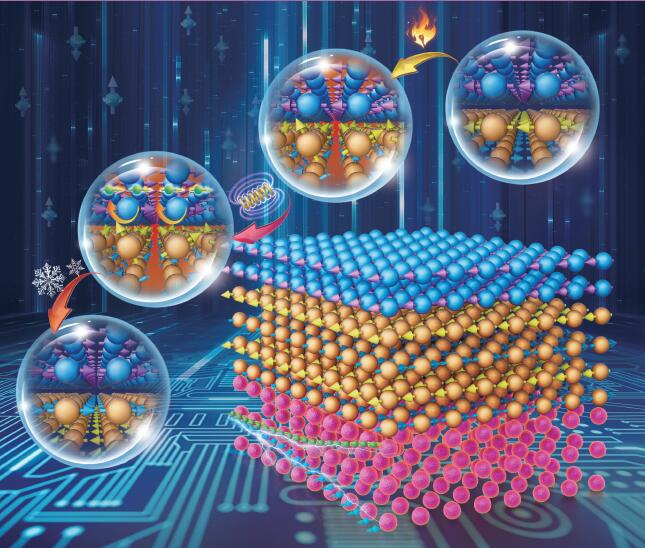SPECIAL TOPIC—Electrical/thermal properties of nanodielectrics
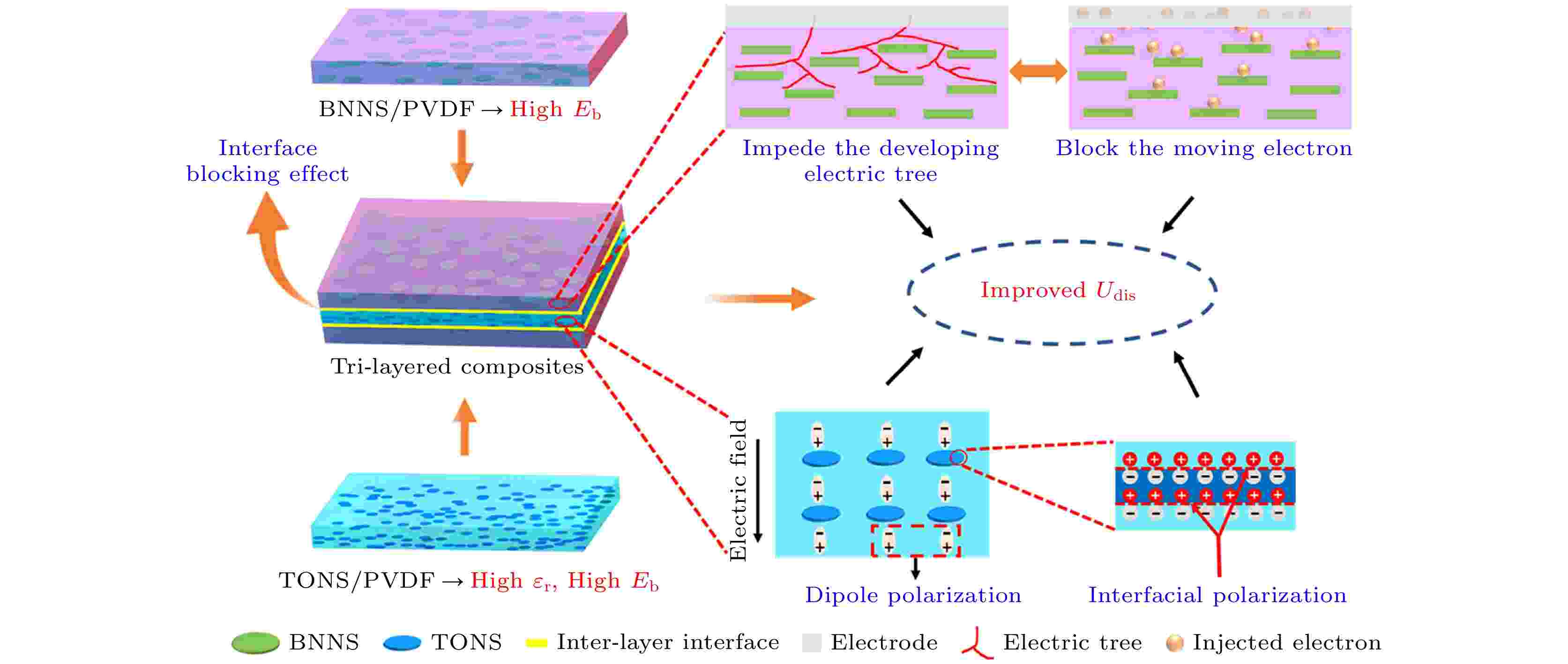
2024, 73 (2): 027702.
doi: 10.7498/aps.73.20230614
Abstract +
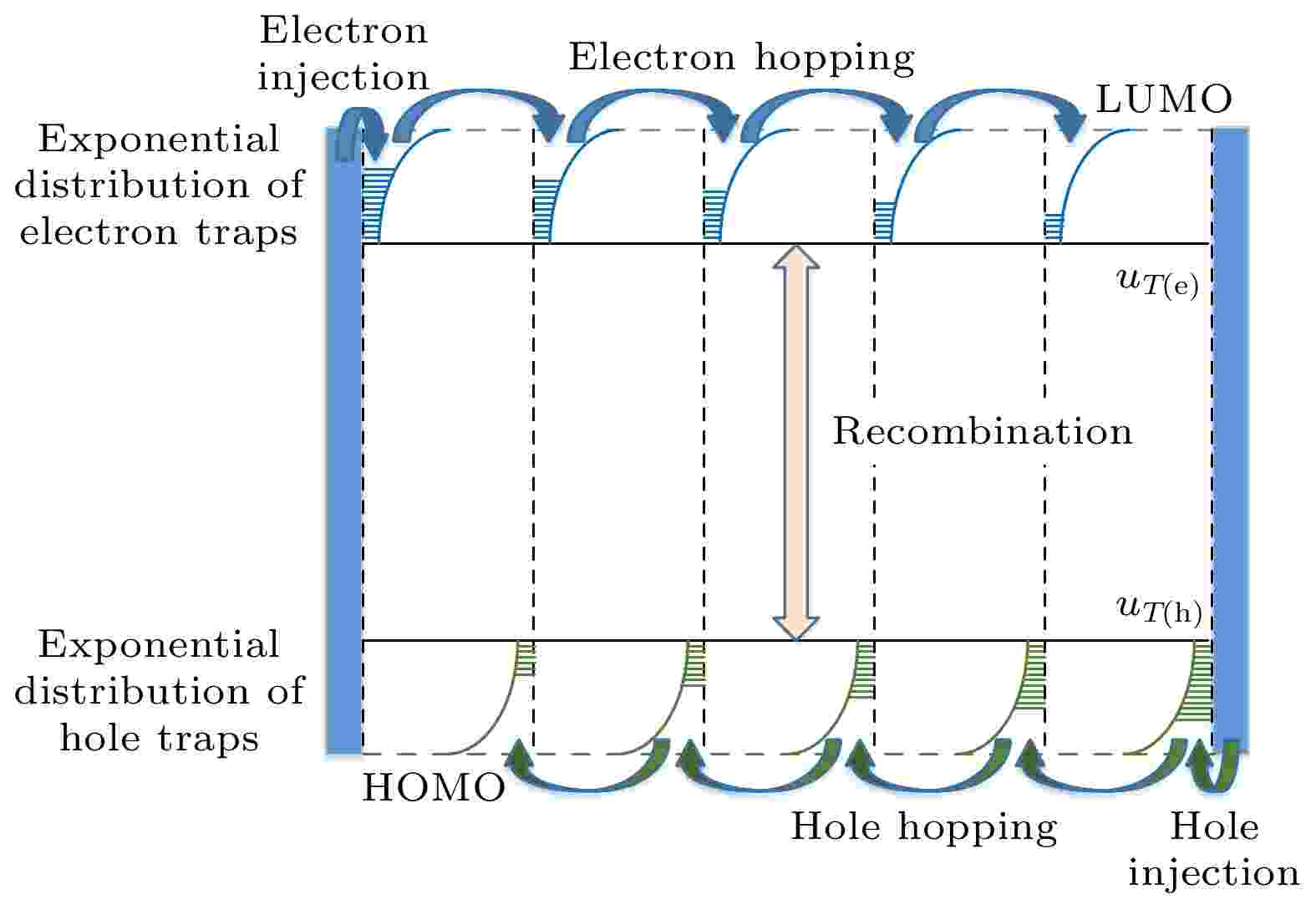
2024, 73 (2): 027301.
doi: 10.7498/aps.73.20230556
Abstract +
With the development of science and technology, polymer dielectric capacitors are widely used in energy, electronics, transportation, aerospace, and many other areas. For polymer dielectric energy storage capacitors to remain effective in practical applications, excellent charge and discharge performance is essential. However, the performance of the common polymer dielectric capacitors will deteriorate rapidly at high temperature, which makes them fail to work efficiently under worse working conditions. Dielectric trap energy levels and trap densities increase when nanoparticles are incorporated into the dielectric. The change in trap parameters will affect carrier transport. Therefore, the high temperature energy storage performance of polymer nanocomposite dielectric can be improved by changing the trap parameters to regulate the carrier transport process. However, the quantitative relationship between trap energy level and trap density and the energy storage properties of nanocomposite dielectric need further studying. In this paper, the energy storage and release model for exponentially distributed trapped charge jump transport in linear polymer nanocomposite dielectrics is constructed and simulated. The volume resistivity and electric displacement-electric field loops of pure polyetherimide are simulated at 150 ℃, and the simulation results match the experimental results, which demonstrates the validity of the model. Following that, under different temperatures and electric fields, the current density, electric displacement-electric field loops, discharge energy density and charge-discharge efficiency of polyetherimide nanocomposite dielectric are simulated by using different trap parameters. The results show that increasing the maximum trap energy level and the total trap density can effectively reduce the carrier mobility, current density and conductivity loss, and enhance the discharge energy density and the charge-discharge efficiency of the nanocomposite dielectric. On condition that temperature is 150 ℃ and applied electric field is 550 kV/mm, the polyetherimide nanocomposite dielectric with a maximum trap energy level of 1.0 eV and a total trap density of 1×1027 m–3, has 4.26 J·cm–3 of discharge energy density and 98.93% of energy efficiency. Compared with pure polyetherimide, the rate of improvement is 91.09% and 227.58%, respectively. The energy storage performance under high temperature and high electric field is obviously improved. It provides theoretical and model support for the research and development of capacitors with high temperature resistance and energy storage performance.

2024, 73 (2): 027703.
doi: 10.7498/aps.73.20230708
Abstract +
Adding nanofillers into epoxy resin matrices is a common method to achieve their multi-function. Boron nitride nanotubes (BNNTs) with one-dimensional nanostructures have attracted much attention because of their ultra-high thermal conductivity, wide energy level band gap, high aspect ratio and mechanical strength. Yet, the strong π-π non-covalent bonding and lip-lip interactions make BNNTs prone to agglomeration in the epoxy resin matrix. Moreover, the different physicochemical properties of BNNTs and epoxy resins as well as the chemical inertness of BNNTs surface lead to the lack of effective interfacial interaction between BNNTs and epoxy resin matrix. Therefore, the performance of the epoxy composite dielectric is not enhanced by simple blending solely, but will even have the opposite effect. To address the problems of BNNTs, in this study, the surface structure of BNNTs is constructed from the perspective of interface modulation by using sol-gel method to coat mesoporous silica (mSiO2) on BNNTs’ surface and further introducing silane coupling agent (KH560). The results indicate that the surface structure of BNNTs can optimize the level of interfacial interaction between BNNTs and epoxy resin matrix, which leads to stronger interfacial connection and elimination of internal pore phenomenon. The dielectric constant and loss of the composite dielectric prepared in this way are further reduced, reaching 4.1 and 0.005 respectively at power frequency, which is significantly lower than that of pure epoxy resin. At the same time, the mechanical toughness (3.01 MJ/m3) and thermal conductivity (0.34 W/(m⋅K)) are greatly improved compared with the counterparts of pure epoxy resin. In addition, the unique nano-mesoporous structure of mSiO2 endows the composite dielectric with a large number of deep traps, which effectively hinders the migration of electrons, thereby improving the electrical strength of the composite dielectric, and the breakdown field strength reaches 95.42 kV/mm. Furthermore, the interfacial mechanism of BNNTs’ surface structure on dielectric relaxation and trap distribution of composite dielectrics is systematically studied by Tanaka multinuclear model. The above results indicate that the good interfacial interaction between BNNTs and epoxy resin matrix is crucial in establishing the micro-interface structure and improving the macroscopic properties of composite dielectrics. This study presents a novel idea for the multifunctionalities of epoxy resin, and also provides some experimental data support for revealing the correlation among surface properties of nano-fillers, microstructure and macroscopic properties of composite dielectric.
GENERAL

EDITOR'S SUGGESTION
2024, 73 (2): 020201.
doi: 10.7498/aps.73.20231164
Abstract +
Majority-vote model is a commonly used model in the study of opinion dynamics. In the original majority-vote model, the influence of node is determined by their neighbors. But there are nodes with low degree surrounded by nodes with high degree so they also have a great influence on the evolution of opinions. Therefore, the influence of a node should not only be measured by neighbors but also be connected to itself directly. Thus, this paper adds collective influence with hierarchical structures into the majority-vote model and measures opinion weight of center node by degree of their neighbors on hierarchical structures surround it with the set distance. The collective influence parameters used in this paper are related to the value of collective influence mentioned above and normalized by the maximum value of all nodes in system. The opinions’ evolution of majority-vote model with collective influence is studied in ER random networks and scale-free networks with different degree distribution exponents by Monte Carlo simulations. It is found that all systems have order-to-disorder phase transitions with the increase of noise parameter. When the depth of hierarchical structure is not zero, the system with collective influence is much easier to turn to disordered states so their critical noise parameters of phase transition are smaller than those of 0-depth systems and original majority-vote model. The reason is that high degree nodes in original majority-vote model have high influence because they are connected to more neighbors and nodes’ influence is also directly determined by degree in 0-depth collective influence model. Furthermore, nodes’ collective influence parameters in the system will all decrease when hierarchical structure of nonzero depth is considered, only a small number of individuals have high influence parameters in the system and they will make the opinions of surrounding individuals follow theirs, so if the opinions of a few highly influential individuals are out of order, then the system will reach a state of disorder. Because of the above factors, the collective influence model of nonzero depth is much easier to disorder with the increase of noise parameter. Besides, the system proves to be easier to reach a disordered state with the increase of degree distribution exponents in scale-free networks because all nodes’ degree will be lower so that the system will be dominated by less nodes with high degree. This conclusion verifies that scale-free networks are more similar to ER random networks with the increase of degree distribution exponents. Finally, through the finite-size scaling method, it is found that the phase transition of the majority-vote model with collective influence of hierarchical structures belongs in the Ising model universal class, whether in ER random networks or in scale-free networks.

2024, 73 (2): 020202.
doi: 10.7498/aps.73.20231231
Abstract +
The pseudo-Landau energy levels of a hexagonal lattice quantum antiferromagnet under bending strain are studied by linear spin-wave theory (LSWT) and quantum Monte Carlo method (QMC). Using the linear spin wave theory, the magnetic pseudo-Landau energy level can be found to appear at the high-energy end of the magnon spectrum, and the energy level spacing is proportional to the square root of the energy level index. The linear spin wave theory and the quantum Monte Carlo method both indicate that at the same size, the local magnetization gradually weakens with the gradual increase of the strain strength. Additionally, the antiferromagnetic order continuously weakens in the y-direction under the same strain strength. This occurs because the Heisenberg chain on the upper boundary becomes decoupled into an isolated vertical chain, leading to the destruction of the magnetic order near the upper boundary. The quantum Monte Carlo method provides a more accurate antiferromagnetic sequence evolution, that is, the vertical correlation at the upper boundary is unchanged and the horizontal correlation increases under a specific strain intensity. This affects the magnetization intensity, so that the local magnetization shows an upward trend at the upper boundary. The results contribute to the understanding of the effect of bending strain on spin excitations, and this effect may be observed in two-dimensional quantum magnetic material experiments.

2024, 73 (2): 020203.
doi: 10.7498/aps.73.20231351
Abstract +
A novel spherical hyperbolic metamaterial (HMM) cavity for enhancing color-transparent display is designed in this work. This HMM cavity consists of a silver core wrapped alternatively by several dielectric layers and silver layers. According to the effective medium theory and Mie scattering theory, we demonstrate that such an HMM cavity supports multiple whispering-gallery modes with deep subwavelength characteristics. The number of whispering-gallery modes with the same angular momentum is equal to the number of silver layers within the HMM cavity. Furthermore, we demonstrate that these excited whispering-gallery modes are capable of strongly confining the electric fields within the different dielectric shell layers, thus reducing Ohmic losses and narrowing resonance linewidths. In addition, we systematically investigate how the structure parameters affect whispering-gallery modes for an HMM cavity with 5 alternative dielectric layers and silver layers. Interestingly, by increasing the thickness of outermost dielectric layer and silver layer, the resonance wavelength of TM1,2 mode and TM1,3 mode remain nearly unchanged. However, the TM1,1 mode experiences a significant blueshift, and the intensity of the TM1,1, TM1,2 and TM1,3 mode can be substantially tuned. Consequently, through structural optimization, the HMM cavity can support triple narrowband resonances in the red, green, and blue spectral regions. Finally, we show that the HMM cavity exhibits dipole radiation characteristics at the three resonance wavelengths, effectively confining light within an angular range from –45° to +45° relative to the incident light direction, and confirming the scattered light viewed from a wide angle. These features make the HMM cavity suitable for achieving high transparency, brightness, and wide viewing angles in full-color transparent displays.

2024, 73 (2): 020301.
doi: 10.7498/aps.73.20231190
Abstract +

EDITOR'S SUGGESTION
2024, 73 (2): 020302.
doi: 10.7498/aps.73.20231425
Abstract +
Based on the exact solution method, the ground state and quench dynamics properties of one-dimensional single-spin flipped Fermi gas with repulsion interaction are studied. With the Bethe wave function, the single-body correlation function and two-body correlation function of the ground state and those between different eigen-states can be reduced into a summation of simple functions, thereby greatly reducing the computational difficulty. For the system in the ground state, the single-body correlation functions and two-body correlation functions as well as momentum distributions for spin-up particles are investigated in real space with different interaction strengths. As the interaction strength increases, the number of nodes in the single-body correlation function remains unchanged, while the amplitude of oscillation decreases. Meanwhile, the number of peaks in the two-body correlation function increases by one due to interaction, indicating that the spin-down particle behaves as a spin-up particle. The momentum distribution becomes more smooth around Fermi surface with the interaction strength increasing. The interaction quench dynamics is investigated. The system is prepared in the ground state of ideal Fermi gas, and then the interaction strength is quenched to a finite positive value. The system evolves under time-dependent Schrödinger equation. The overlap between the initial state and eigen-state of post-quench interaction strength is expressed in the form of continued multiplication. The square of the modulus of this overlap, which represents the occupation probability, is calculated. We find that the occupation probabilities of the ground state and doubly degenerated excited state always have the first and the second largest value for an arbitrary interaction strength, respectively, which means that the difference in eigenenergy between these two states gives the primary period of oscillation. For relatively large particle number ($ N\geqslant10$ ), the primary period always does not change under different interaction strengths.It is found that in the case of interaction quenching, the momentum distribution and the correlation function show periodic oscillations. When the interaction strength is adjusted to a relatively small value, the oscillation periodicity is well-defined and the oscillation amplitude is small. The system can be approximated by a two-level model. When the interaction strength increases to a very large value, the oscillation periodicity worsens and the amplitude increases, but a primary period remains unchanged. Although the overall deviation is far from the initial state, it is very close to the initial state at time $ t=mL^2/(2\pi\hbar)$ . This is because the difference between most energy eigenvalues is almost an integral multiple of energy unit $ 2\times\left(2\pi/L\right)^{2}$ .

EDITOR'S SUGGESTION
2024, 73 (2): 020303.
doi: 10.7498/aps.73.20231289
Abstract +
Quantum computing can solve problems that are difficult to solve in classical computing, expanding the range of problems that can be effectively computed within the allowable range of classical physical principles, and posing a challenge to the extended Church-Turing thesis in classical computing. Here, we discuss an interesting question: how to achieve more powerful computers by breaking through the limitations of physical principles, further enhancing the capabilities of quantum computers. To extend quantum computing, novel operations related to relativistic physics are a crucial candidate. Among them, the concept of closed time-like curve has aroused widespread interest, and it introduces the ability for time travel. Mathematically, quantum state along the closed time-like curve is determined through self-consistent equations, which has been demonstrated in simulations. Here, we consider a novel manipulation capability that allows quantum computing to achieve time-travelling quantum control gate. This is an intuitive extension of the graphical language of quantum circuits. Explaining quantum circuits as tensor networks, we first explain how to experimentally simulate the output of such a circuit in a system without time-travel capability. Then, we take an example to demonstrate an extended quantum algorithm that can efficiently solve SAT problems, indicating that with the involvement of time-travelling quantum gates, the computational complexity class P = NP. We also anticipate that the time-travelling quantum gates will play a facilitating role in accomplishing other quantum tasks, including achieving deterministic non-orthogonal quantum state discrimination, and quantum state cloning. Our results contribute to a more in-depth understanding of the relationship between computation and physical principles.

2024, 73 (2): 020304.
doi: 10.7498/aps.73.20230138
Abstract +
Continuous variable quantum secret sharing protocol can guarantee the unconditional security of secret key information based on the fundamental laws of physics. However, the state preparation operation may become non-ideal and imperfect in practical continuous variable quantum secret sharing scheme, which will introduce additional excess noise and affect the security of the scheme. Therefore, it is necessary to analyze it. We propose a practical continuous variable quantum secret sharing protocol based on imperfect state preparation. Specifically, in the proposed scheme, we assume that there are multiple users, and the imperfect state preparation performed by any user is equivalent to the corresponding untrusted third party using a phase insensitive amplifier to amplify the ideal modulator and laser owned by the user. The equivalent excess noise introduced by the imperfect state preparation can be calculated comprehensively and quantitatively through the gain of the corresponding phase insensitive amplifier. The results show that the continuous variable quantum secret sharing scheme is sensitive to the excess noise introduced by the imperfect state preparation operation, which will inevitably reduce its performance and security. Fortunately, the upper bound of the additional excess noise tolerance for the imperfect state preparation is achieved by using the specific gain formula of the phase insensitive amplifier, thus the security risks caused by the imperfect state preparation can be effectively solved. Due to considering the additional excess noise introduced by imperfect state preparation, tighter secret key rate curves can be obtained by the proposed scheme than those by the ideal continuous variable quantum secret sharing protocol. These results indicate that the proposed scheme can improve the practical security of continuous variable quantum secret sharing scheme, and provide a theoretical basis for its practical applications.
2024, 73 (2): 020401.
doi: 10.7498/aps.73.20231277
Abstract +
In recent years, thermodynamics and phase transitions of black holes in extended phase space have been extensively studied. The results show that the original first law of thermodynamics needs revising and new phase transitions will appear. However, so far, Hawking tunneling radiation has not been widely studied in the extended phase space. In particular, whether the tunneling radiation probability changes at this time is still uncertain. This work focuses on this topic, that is, to calculate the specific value of the tunneling probability in the extended phase space and ascertains whether the results obtained in the normal phase space are consistent with those in the extended phase space. The methods used herein are described below. Taking Reissner-Nordstrom-AdS black holes with global monopole for example, the cosmological parameters are regarded as dynamic variables, which is different from previous treatment methods that regard them as constants and ignore their contributions to the tunneling probability. In particular, cosmological parameters are introduced and regarded as thermodynamic pressure when the tunneling probability is calculated, and their contribution to the tunneling probability is considered. In the work the tunneling process of mass particles is mainly studied. The outgoing particles are viewed as spherical de Broglie waves, and then the relative phase velocity and group velocity are calculated. The geodesic equation is obtained according to the relationship between the two velocities, and the tunneling probability is calculated from the geodesic equation. It is concluded that the results show that the tunneling probability of the ingoing particles is proportional to the difference in the Bekenstein-Hawking entropy of the black hole before and after the particles tunnel, and the radiation spectrum deviates from the pure thermal spectrum, which is exactly the same as the case that the cosmological parameters are treated as constants. This means that the tunneling probability of particles can be obtained in the extended phase space, and the tunneling process does not depend on thermodynamic parameters. In addition, it is found that although the global monopole affects the dynamical behavior and thermodynamic quantity of the particle, it does not affect the entropy change or tunneling rate. In other words, the conclusion that the tunneling probability in extended phase space is exactly the same as that in normal phase space does not depend on the space-time topology.

2024, 73 (2): 020701.
doi: 10.7498/aps.73.20231265
Abstract +
Hydrogen, as one of the most well-developed green energy materials, has played an important role in industrial development, human production and life, and the treatment of diseases in recent years. Hydrogen sensor is an important safety monitoring equipment in chemical production. Developing long-term and efficient hydrogen gas sensor for real-time monitoring has become increasingly important and urgent. Hydrogen, as one of the main combustible gases present in the petrochemical production process, is of great research significance and challenging in meeting the need of cycling gas identification and highly sensitive detection. Therefore, it is of great practical value to develop the low-cost, low-power and highly sensitive miniature hydrogen gas sensors . In this work, a gold-doped tin dioxide nanostructured ultra-sensitive and highly specific micro-nanosensor is obtained based on the in-situ synthesis of micro-hot plates. It is shown that the sensitivity of this nanosensor is as high as 100 for hydrogen at 50 ppm, and the sensitivity of ethanol, an important interference gas, is only 1/22 of that of hydrogen at the same concentration, which has an obvious suppression effect. For the same concentration of carbon monoxide, methane and other interference gases do not show any response. XPS characterization shows that the defective oxygen ratio of the material is the main reason for the ultra-sensitivity of the sensor. Meanwhile, in this study, the precursor solution of gold-doped tin dioxide is prepared by using chloroauric acid and tin tetrachloride crystals as raw materials; the nanosized morphology structure is prepared by templating the generation of sensitive materials using polystyrene microspheres; the in-situ synthesis method is realized by applying a voltage to the calcination of a micro hot plate. Through this nanoscale templating in-situ heating method, a gold-loaded tin dioxide nanosensor is prepared. Note that the template assisted in-situ grown $ {\mathrm{A}}{\mathrm{u}} $ loaded Tin Oxide nano sensor is abbreviated as $ {\mathrm{T}}{\mathrm{I}}{\mathrm{S}}\text{-}{\mathrm{Au}}\text{-}{{\mathrm{S}}{\mathrm{n}}{\mathrm{O}}}_{2} $ Sensor . In order to illustrate the sensing mechanism, we analyze the elemental compositions, and the results show that under the condition of the high defective oxygen content, the in-situ heating method of templated preparation of $ {\mathrm{A}}{\mathrm{u}}\text{-}{{\mathrm{S}}{\mathrm{n}}{\mathrm{O}}}_{2} $ nano-sensor containing arrays of polystyrene spheres becomes an important reason for the ultra-sensitivity to hydrogen, high specificity, and the suppression of the important interfering gas, ethanol. Moreover, the in situ preparation method can be flexibly and scalably used to prepare high-performance miniaturized gas sensors with a variety of hollow-sphere nanostructured metal oxides, in order to obtain excellent sensitivity and adjustable selectivity.

2024, 73 (2): 020702.
doi: 10.7498/aps.73.20231224
Abstract +
CO2 is one of the main greenhouse gases. Its emission and accumulation lead to the strengthening of the greenhouse effect, which in turn causes global climate change. Therefore, it is of great significance to obtain the change of CO2 concentration in the atmospheric environment for the study of climate change. In order to meet the requirements of low cost, fast, on-line and accurate measurement of CO2 in atmospheric environment, a CO2 gas concentration measurement system based on Fabry-Perot interferometer is built in this work. The thermal radiation source based on micro-electro-mechanical system (MEMS) technology is used as a light source of the Fabry-Perot interferometer system, and the transmission optical path is designed to replace the common refractive optical path. By electrostatically controlling the distance between the two lenses and changing the interference spectrum, the interference peak adjustment of the center wavelength of the 10 nm step is realized, and the absorption spectrum is obtained by scanning. Based on the principle of differential optical absorption spectroscopy, the concentration of CO2 gas is obtained, and the real-time on-line monitoring of CO2 concentration is realized. Using the sample gas calibration system and the commercial photoacoustic spectroscopy multi-gas analyzer to verify the system, the results show that the detection limit of the system is 1.09×10–6, the detection accuracy is ±1.13×10–6, and the measurement error is less than 1%. Real-time online monitoring of atmospheric CO2 has been conducted in Huaibei, a coal city. A comparative observational experiment is performed between this system and a commercial photoacoustic spectroscopy multi-gas analyzer. The two systems show consistent trends in measuring CO2 variations, with a correlation coefficient of R=0.92. It shows that the Fabry-Perot interferometer system can meet the requirement of rapid, convenient and high precision measurement of CO2 concentration in the environment.
ATOMIC AND MOLECULAR PHYSICS

2024, 73 (2): 023101.
doi: 10.7498/aps.73.20231304
Abstract +
When biomolecules interact with high-energy particles and rays, they are directly ionized or dissociated, then a large number of low-energy electrons are formed as secondary particles. These low-energy electrons will attach to biomolecules, and trigger off the secondary dissociation, forming free radicals and ions with high reactivity, which can damage the structure and function of the biomolecule and cause irreversible radiation damage to the biomolecule. It is important to study the low-energy dissociative electron attachment (DEA) process of biomolecules for understanding radiation damage to biological organisms. Currently, the theoretical studies of DEA have mainly focused on the bound states of negative ions and the types of resonances in the dissociation process. The dissociation process is well described by quantum computational method, but the diversity and complexity of dissociation channels present in the dissociation process of 2-thiouracil molecule also pose a great computational challenge to these methods. In addition, the quantum computational methods are not ideal for dealing with the discrete states of chemical bonds and the problem of continuity coupling of electrons. The dissociation dynamics of biomolecules mainly results from ionization and electron attachment. Ab initio molecular dynamics simulation can reasonably describe these processes. In light of these considerations, ab initio molecular dynamics simulation is used in this work to study dynamic variation process in DEA. The low-energy electron dissociative attachment to 2-thiouracil in the gas phase is studied by using the Born-Oppenheimer molecular dynamics model combined with density functional theory. It is found that an important dehydrogenation phenomenon of 2-thiouracil and its tautomers occurs in the DEA process, and that the N—H and C—H bond are broken at specific locations. Due to the loss of hydrogen atoms at the N and C sites, the closed-shell dehydrogenated negative ion (TU-H)– forms, which is the most important negative ion fragments in the dissociation process. The potential energy curves, the bond dissociation energy and the electron affinity energy of the broken bond show that the N—H bond is the most likely to break, indicating the formation of the negative ion (TU-H)– mainly comes from the breaking of N—H bond. The theoretical calculations in this work are in good agreement with the available experimental results, indicating that the chosen calculation method is fully reliable. The BOMD simulations can not only dynamically recover the process of dissociative attachment of low-energy electrons to 2-thiouracil, but also more importantly provide an insight into the mechanisms of dehydrogenation and dissociation channels of 2-thiouracil molecules in DEA process.
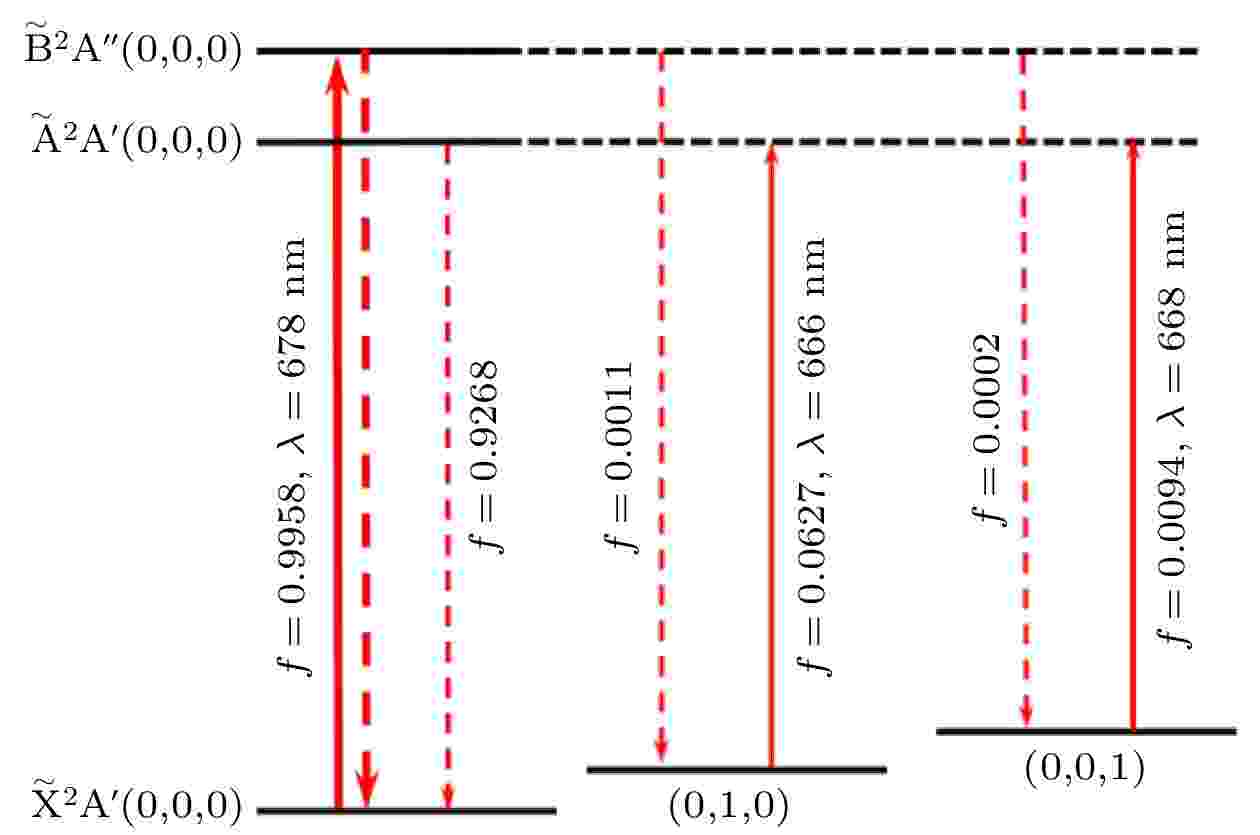
EDITOR'S SUGGESTION
2024, 73 (2): 023301.
doi: 10.7498/aps.73.20230742
Abstract +
The CaSH molecule is an important target in the field of laser cooling non-linear polyatomic molecules. Successful cooling of such molecules marks a breakthrough of the technical limitations of laser cooling diatomic and linear triatomic molecules. To identify the possible optical cycle in cooling CaSH, precise geometries of the CaSH ground state and the three lowest excited states, along with their excitation energy, are determined by utilizing the EA-EOM-CCSD (electron attachment equation-of-motion coupled cluster singles and doubles) method, in combination with energy extrapolation using cc-pVXZ/cc-pCVXZ (X = T, Q ) serial basis sets. Geometric parameters of the ground state $ {\tilde{{\mathrm{X}}}}^{2}{{\mathrm{A}}}^{\prime} $ are found to be RCaS= 2.564 Å, RSH= 1.357 Å, and∠CaSH= 91.0°. Additionally, the equilibrium geometries of three excited states are also obtained. The $ {\tilde{{\mathrm{B}}}}^{2}{{\mathrm{A}}}^{\prime\prime} $ state has a similar equilibrium structure to the ground state, while the $ {\tilde{{\mathrm{A}}}}^{2}{{\mathrm{A}}}^{\prime} $ and $ {\tilde{{\mathrm{C}}}}^{2}{{\mathrm{A}}}^{\prime} $ states exhibit significant conformer distortions. Specifically, the CaS bond of the $ {\tilde{{\mathrm{A}}}}^{2}{{\mathrm{A}}}^{\prime} $ state and $ {\tilde{{\mathrm{C}}}}^{2}{{\mathrm{A}}}^{\prime} $ state tend to contract, and the CaSH angel bends by 5° relative to the ground state. The vertical excitation energy from the ground state to $ {\tilde{{\mathrm{A}}}}^{2}{{\mathrm{A}}}^{\prime} $ , $ {\tilde{{\mathrm{B}}}}^{2}{{\mathrm{A}}}^{\prime\prime} $ and $ {\tilde{{\mathrm{C}}}}^{2}{{\mathrm{A}}}^{\prime} $ are of 1.898, 1.945 and 1.966 eV, respectively, which are in good agreement with the previous experimental results. Moreover, the potential energy surfaces of the four lowest electronic states of CaSH are calculated by EA-EOM-CCSD with 3ζ level of basis sets. The nuclear equations of motion are solved to obtain the vibrational frequencies of the CaS bond stretching and CaSH bending. The vibrational frequencies of the (0,1,0) mode and the CaS stretching frequency of four states are 316 cm–1, 315 cm–1, 331 cm–1 and 325 cm–1, which are in close agreement with the available experimental results. The frequencies of the CaSH bending mode are presented for the first time, with the values of 357 cm–1, 396 cm–1, 384 cm–1, 411 cm–1 for the $ {\tilde{{\mathrm{X}}}}^{2}{{\mathrm{A}}}^{\prime} $ , $ {\tilde{{\mathrm{A}}}}^{2}{{\mathrm{A}}}^{\prime} $ , $ {\tilde{{\mathrm{B}}}}^{2}{{\mathrm{A}}}^{\prime\prime} $ and $ {\tilde{{\mathrm{C}}}}^{2}{{\mathrm{A}}}^{\prime} $ states, respectively. Theoretical calculations give the Frank-Condon factors of 0.9268, 0.9958 and 0.9248 for the $ {\tilde{{\mathrm{X}}}}^{2}{{\mathrm{A}}}^{\prime} ({\mathrm{0,0}},0) $ to $ {\tilde{{\mathrm{A}}}}^{2}{{\mathrm{A}}}^{\prime} ({\mathrm{0,0}},0) $ , $ {\tilde{{\mathrm{B}}}}^{2}{{\mathrm{A}}}^{{{\prime} }{{\prime} }}({\mathrm{0,0}},0) $ and $ {\tilde{{\mathrm{C}}}}^{2}{{\mathrm{A}}}^{\prime} ({\mathrm{0,0}},0) $ transitions. All three excited states are the bright states with considerable oscillator strength relative to the ground state. Based on the Frank-Condon factor and lifetime of excited states, the $ {{\tilde{{\mathrm{X}}}}^{2}{{\mathrm{A}}}^{\prime} ({\mathrm{0,0}},0)\to \tilde{{\mathrm{B}}}}^{2}{{\mathrm{A}}}^{{{\prime} }{{\prime} }}({\mathrm{0,0}},0) $ transition is regarded as the main cooling cycle for the CaSH molecule. The corresponding pump light wavelength is 678 nm. By exciting the vibrational excited states (0,1,0) and (0,0,1) of the $ {\tilde{{\mathrm{X}}}}^{2}{{\mathrm{A}}}^{\prime} $ state to $ {\tilde{{\mathrm{A}}}}^{2}{{\mathrm{A}}}^{\prime} ({\mathrm{0,0}},0) $ using lasers at 666 nm and 668 nm, respectively, the optical cooling branch ratio of CaSH is expected to exceed 0.9998.
ELECTROMAGNETISM, OPTICS, ACOUSTICS, HEAT TRANSFER, CLASSICAL MECHANICS, AND FLUID DYNAMICS

EDITOR'S SUGGESTION
2024, 73 (2): 024201.
doi: 10.7498/aps.73.20231365
Abstract +
The design of thin frequency selective surface (FSS) absorber based on resistive film that meets the requirements of broadband, polarization independence, incident angle stability, and strong absorption is a challenging task. Fabrication tolerance of resistive film can result in fluctuations in sheet resistance, which negatively affects the absorber performance. To tackle these problems, this work firstly investigates how sheet resistance fluctuations affect the absorbing performance of resistive film FSS absorber. The analysis of simulated surface current density distribution and impedance reveals that the diversity of current paths provides an effective way to mitigate the influence of sheet resistance fluctuation. This is achieved by enabling flexible variation of surface current in response to sheet resistance fluctuations. Consequently, the variation of input impedance of the FSS absorber due to the fluctuation of sheet resistance is suppressed within a small range. Then, a method of extending bandwidth is proposed by employing the complementary variation of FSS impedance with frequency at different layers. By combining this approach with a miniaturization design, a thin and light FSS absorber is developed that exhibits ultra-wide bandwidth, polarization independence and angle stability while mitigating the effects of sheet resistance perturbation. The proposed FSS absorber achieves a 90% absorption bandwidth from 1.50 GHz to 20.50 GHz, covering Ku, X, C, S bands and part of the L and K bands, with a relative bandwidth reaching 173%. The absorber has a thickness of 0.093λL for both transverse electric (TE) polarization and transverse magnetic (TM) polarization, yielding a figure of merit (FoM, the ratio of the theoretical minimum thickness to the actual thickness) of 0.95, indicating that the thickness is close to the theoretical limit. The absorber maintains over 90% absorption rate for TM polarization at an incidence angle of up to 70°, and 80% absorption for TE polarization at 45°. Furthermore, the 90% absorbance bandwidth of the absorber remains at 167.0% when the sheet resistance of any FSS layer fluctuates within a range from 12 to 30 Ω/sq. A prototype of the proposed FSS absorber is fabricated and measured, and the experimental results are in good agreement with the simulation results, thus validating the effectiveness of the proposed method.
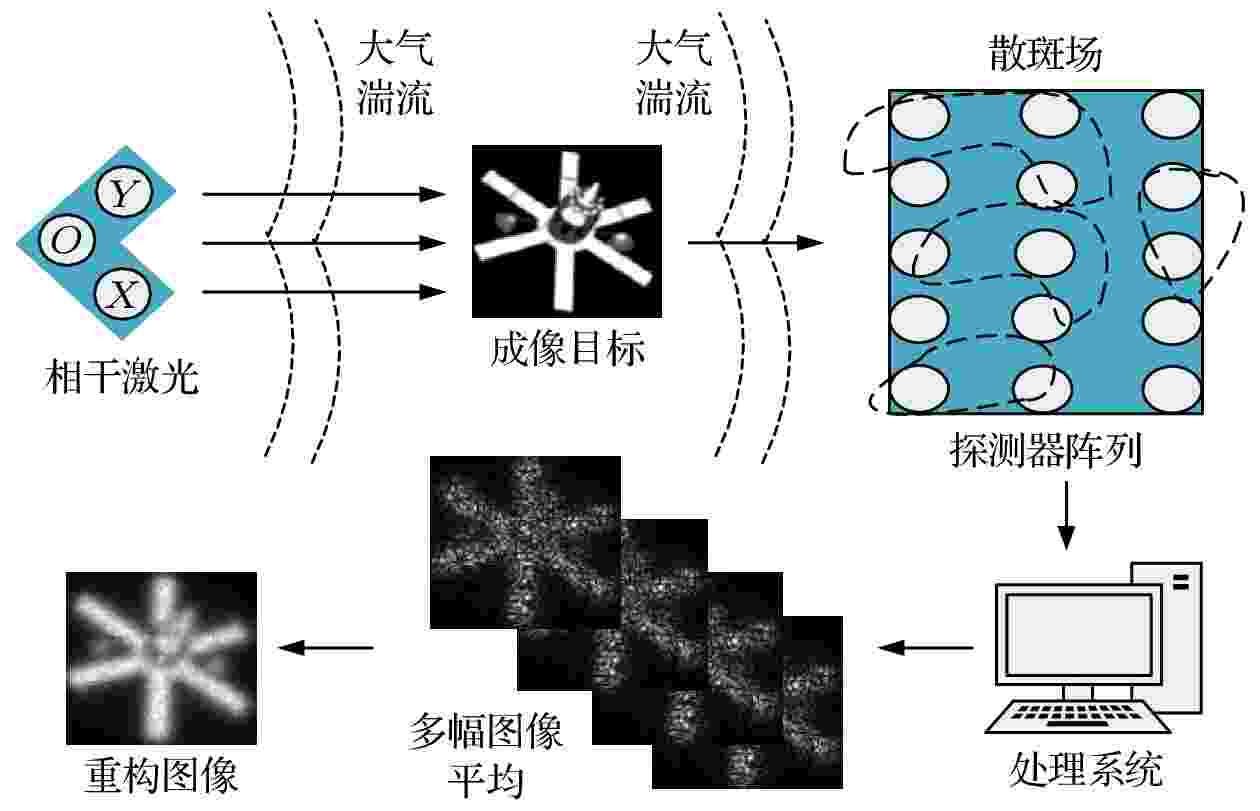
2024, 73 (2): 024202.
doi: 10.7498/aps.73.20231254
Abstract +
Sheared-beam imaging (SBI) is an unconventional ground-based optical imaging technique. It breaks through the traditional optical imaging concept by using three coherent laser beams, which are laterally displaced at the transmit plane, to illuminate the target, reconstructing the target image from echo signals. However, the echo data sampling of the imaging system is still not fast enough to reconstruct the high resolution and clear image of the target when imaging the target that is at rapidly changing position and attitude. In order to solve this problem, in this work an image reconstruction method is proposed based on five-beam fast sampling. An emitted beam array arranged in the cross shape with a central symmetrical structure is proposed, and the encoding and decoding method of the imaging system are changed. With a single exposure, the echo signals carry more spectrum information of the target, and the number of reconstructed images can be increased from 1 to 8, which quickly suppresses the speckle effect of the reconstructed image. Firstly, the principle of the imaging technique based on fast sampling is presented. Then, an image reconstruction algorithm based on fast sampling is studied. Eight groups of phase differences and amplitude information of the target can be extracted from echo signals. The wavefront phases are solved by the least-squares method, and wavefront amplitude can be obtained by the algebraic operation of speckle amplitude. The target image is reconstructed by the inverse Fourier transform. The simulation results show that comparing with the traditional three-beam image reconstruction method, the sampling times of echo data needed to obtain the same quality image are reduced from 20 to 5, which greatly reduces the sampling times of echo data and improves the sampling rate of echo data.

2024, 73 (2): 024203.
doi: 10.7498/aps.73.20231408
Abstract +
Coherent population trapping (CPT) oscillation is a transient oscillation phenomenon based on the CPT effect, which is related to the Raman detuning of the coherent bichromatic laser fields from the hyperfine ground-states of three-level Λ system. In this work, sawtooth wave is adopted to modulate the frequency of microwave signal to make Raman detuning change uniformly and stepping. Meanwhile, by building the relationship between the microwave frequency modulation rate and the change rate of Raman detuning, the effects of the change rate and mode of Raman detuning on CPT oscillation are analyzed respectively. The results reveal that when the Raman detuning changes uniformly, the CPT oscillation will occur on condition that the change rate is high enough, and the excited oscillations show non-harmonic oscillation behavior. When the Raman detuning is triggered off by step change, the excited CPT oscillation is a damping oscillation, and the oscillation frequency is equal to the frequency of Raman detuning. The modulation of Raman detuning is realized by using sawtooth wave to modulate the microwave frequency, and then the complete establishment of CPT state and the complete attenuation of CPT oscillation process are achieved. This work presents a new modulation method to realize the CPT oscillation, which shows great application potential in the field of weak magnetic measurements and atomic clocks.
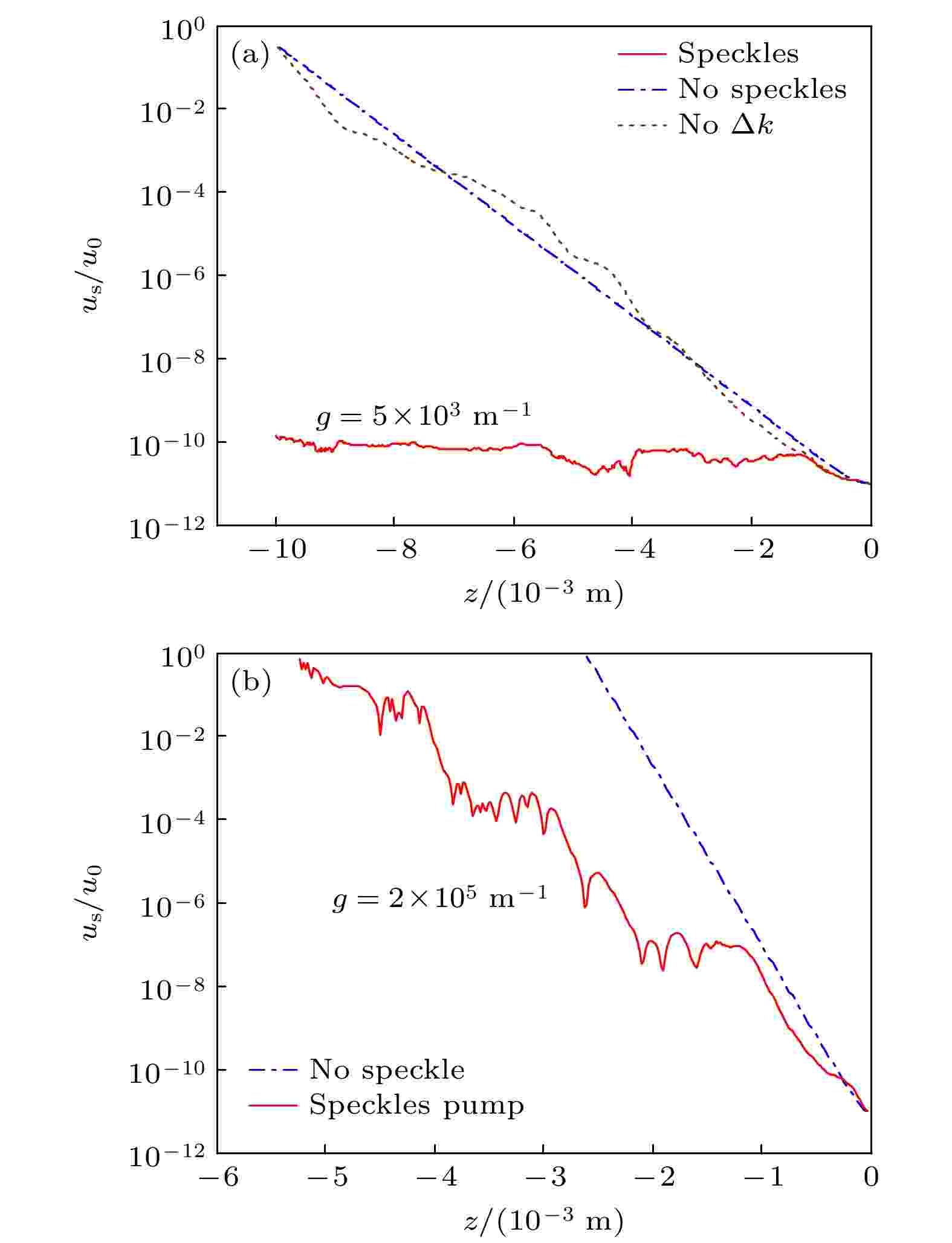
2024, 73 (2): 024204.
doi: 10.7498/aps.73.20231235
Abstract +
Speckle field is a relatively common phenomenon. But the speckle has special application value in nonlinear optical domain because it can be used to suppress different nonlinear processes that are caused by high power laser. To enhance the suppression capability, it is necessary to reveal the basic mechanism of the speckle parameter nonlinear optical interaction process. In this work, the coupling wave equation under the wave number mismatch condition is used to analyze the parameter process of speckles field. The solving process of the coupling wave equation is introduced in detail. And the wave number or phase matching condition is fully discussed. Furthermore, the threshold of the nonlinear gain is analyzed when the wave number does not fully meet the matching condition. To describe the solution of the coupling wave equation more clearly, the undetermined coefficient of the exact analytical solution is discussed. Since the boundary field will affect the confirmation of the undetermined coefficient, the characteristic of boundary field should be analyzed first. The nonlinear process of the speckle field is a three-wave interaction process. The different boundary conditions will affect the three-wave interaction process. And it is found that if the complex amplitudes of the three waves at the boundary are not zero, the undetermined coefficient will be changed with the phrase parameters of the three waves. To achieve the maximum value, the boundary waves must meet the phase matching condition. The wave number of the speckle filed is not an invariant, because of its random distribution characteristic. Therefore, during the analysis of the three-wave interaction process, the segment handling method is used to ensure the effective solving of the first order coupling wave equation. On the other hand, the randomly fluctuation of the wave number destroys the phase matching condition of the boundary. It is just through the basic mechanism that the speckle field can be used to suppress the nonlinear gain of high-power optical field. Both the theoretical analyses and the numerical calculation results show that the speckle field has good suppression effect for some typical nonlinear parameter process, such as stimulated Brillouin scattering.

EDITOR'S SUGGESTION
2024, 73 (2): 024205.
doi: 10.7498/aps.73.20231214
Abstract +

2024, 73 (2): 024401.
doi: 10.7498/aps.73.20231142
Abstract +
This work is devoted to investigating the difference in flow and heat transfer characteristics between vertical upward flow and horizontal flow of supercritical carbon dioxide ($\rm sCO_2$ ) based on the pseudo-boiling theory and the experimental parameters: mass flux G = 496–1100 kg/m2s, heat flux qw = 54.4–300.2 kW/m2, and pressure P = 7.531–20.513 MPa. The differences in flow and heat transfer characteristics between horizontal upward tube and vertical upward tube are compared at different mass fluxes, heat fluxes and pressures fully. Finally, unlike the classical treatment of flow and heat transfer for supercritical fluid, single-phase fluid assumption is abandoned, instead, the pseudo-boiling theory is introduced to deal with the flow transfer and heat transfer of $\rm sCO_2 $ in the two tubes. Supercritical fluid is regarded as a multiphase structure in this work, including a vapor-like layer near the wall and a liquid-like fluid in tube core. The results are indicated below. 1) In terms of heat transfer, the inner-wall temperature of the vertical upward tube and the bottom generatrix of horizontal tube are basically the same under normal heat transfer mode. When the heat transfer deterioration occurs in the vertical upward tube, larger supercritical boiling number (SBO) will cause the wall temperature peak of the vertical upward tube to be much higher than the wall temperature at top generatrix of the horizontal tube at the corresponding enthalpy. The SBO (SBO = 5.126×10–4) distinguishes between normal heat transfer deterioration and heat transfer deterioration in the vertical upward tube. In the horizontal tubes, SBO dominates the maximum wall temperature difference between the top generatrix and the bottom generatrix. Comparing with vertical upward tubes, higher qw/G is required for the heat transfer deterioration of supercritical fluid in the horizontal tubes under the same pressure. 2) In terms of flow, the increase in slope of pressure drop in the vertical upward tube is due to the orifice contraction effect. The mechanism that dominates the variation of pressure drop in the horizontal tube is the flow stratification effect, and we show that Froude number Frave can be the similarity criterion number to connect the temperature difference between the top and bottom generatrix of horizontal tube and the pressure drop. The analysis suggests that mechanisms governing horizontal flow and vertical flow of $\rm sCO_2 $ are different in heat transfer deterioration mode. For the vertical flow, the SBO plays a leading role, while for the horizontal flow, the Fr plays an indispensable role.
PHYSICS OF GASES, PLASMAS, AND ELECTRIC DISCHARGES
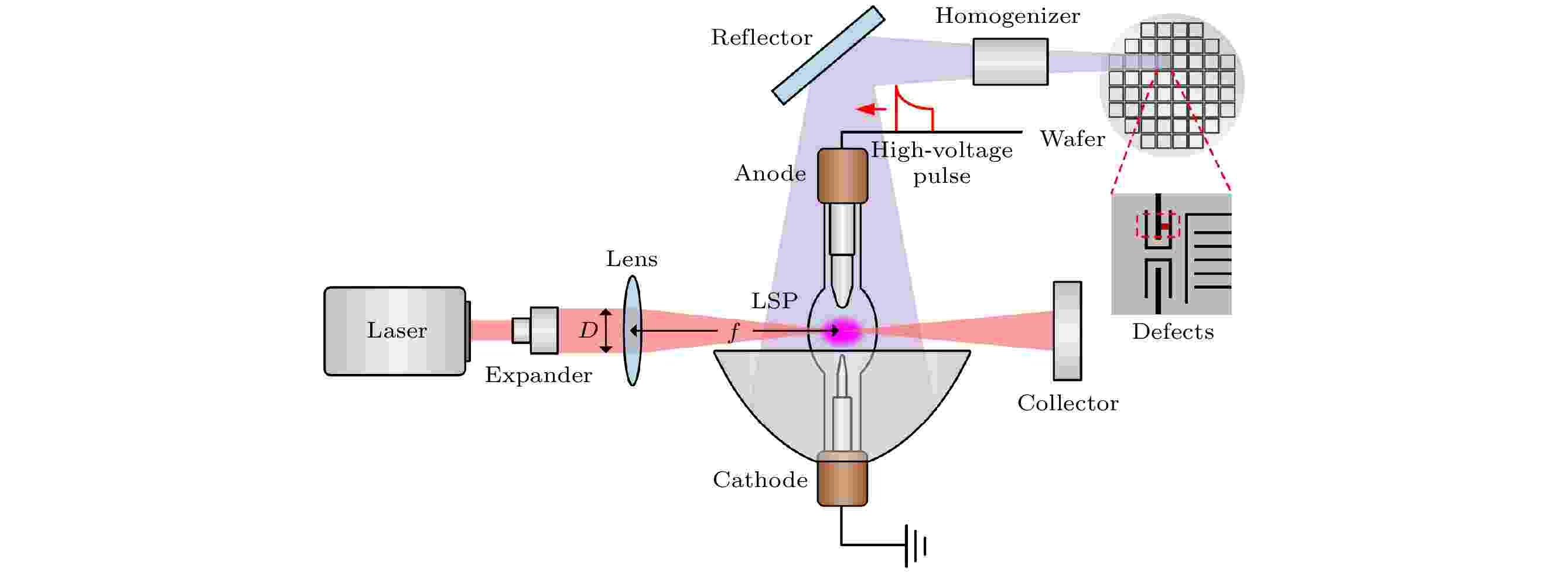
2024, 73 (2): 025201.
doi: 10.7498/aps.73.20231056
Abstract +
Laser-sustained plasma (LSP), which can be utilized for a novel radiation light source, has advantages such as high irradiance, broad spectral range, and stable emission, demonstrating significant applications in wafer inspection in the field of the semiconductor industry. This paper revisits the historical development of LSP research and introduces fundamental physical processes in LSP. The mathematical description equations for LSP and methods of calculating plasma parameters are provided, thereby a time-dependent two-dimensional fluid model is established by taking into consideration a laser-thermal-hydrodynamic coupling effect. The propagation of the laser in plasma is investigated based on the established model, and the fundamental processes in LSP, including the initial evolution process, laser energy deposition, steady-state characteristics, and instability, are explored. The effectiveness of the simulation model is confirmed through comparing with the experimental results of high-pressure Xe LSP. The findings indicate that the mode, power, F-number of incident lasers, as well as parameters including components, pressure, and flow velocity of gas, can all affect the steady-state properties of LSPs. Under the identical power and F-number conditions, Gaussian mode laser and annular mode laser both produce LSPs with different shapes and positions. Notably, under the conditions of high-power annular laser incidence, large laser F-number, and high flow velocity, the simulation results reveal temporal and spatial instability in LSP. These simulation results contribute significantly to a more in-depth understanding of the underlying physical mechanisms of the LSP. Furthermore, they provide a theoretical basis for designing the light source system and optimizing the multiple parameters. The influence of laser parameters on LSP properties elucidated in this study not only advances the fundamental understanding of LSP but also offers crucial insights for designing and optimizing the light source systems in various applications, particularly in the field of optical detection for semiconductor wafer inspection.
CONDENSED MATTER: STRUCTURAL, MECHANICAL, AND THERMAL PROPERTIES
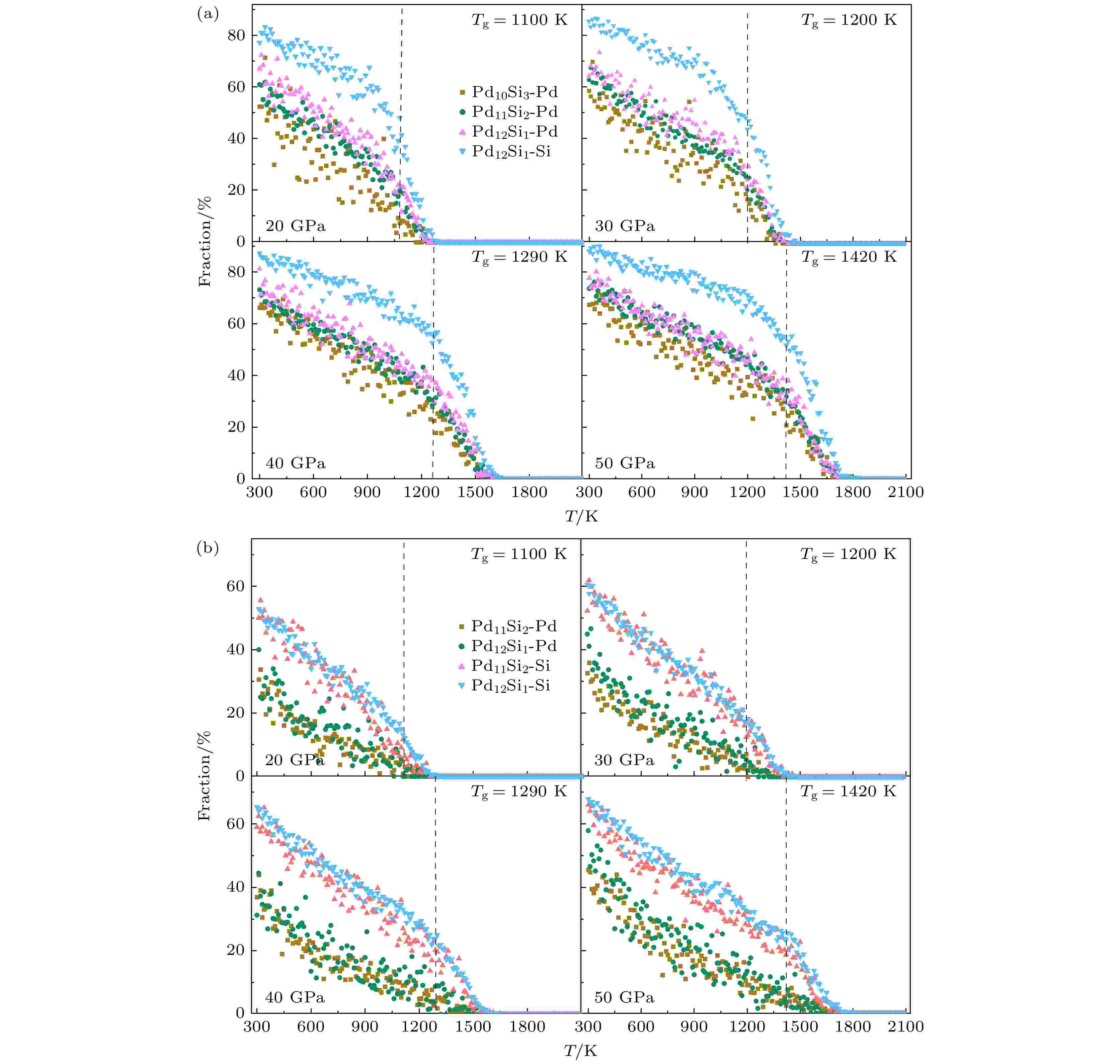
Analysis of icosahedral structure in rapidly solidified Pd82Si18 amorphous alloy under high pressure
2024, 73 (2): 026101.
doi: 10.7498/aps.73.20231101
Abstract +
Compared with traditional glass, metallic glass (MG) has excellent properties, such as high strength, high hardness, high fracture toughness, good soft magnetic properties and corrosion resistance due to its unique structure. Such properties enable it to be used in optics, electronics, construction and other fields, making it a highly promising new material with great application potential. As the properties of amorphous alloys are closely linked with their local structures, microstructure characteristics have always been a research focus in the amorphous field. Previous studies show that the onset temperature of heredity and the hereditary fraction of characteristic clusters can be used to effectively evaluate the glass-forming ability. In order to obtain the relationship between the microstructure characteristic and cluster evolution of amorphous alloy, and reveal the formation of glass, the glass transition processes of the Pd82Si18 alloy under different pressure conditions are simulated by using the molecular dynamics method, and the heredity and evolution of the Pd82Si18 amorphous alloy are analyzed by using the cluster-type index method and the reverse tracking method. The simulation results show that the glass transition temperature of the Pd82Si18 alloy can be increased when the pressure is higher, and a large number of icosahedra are formed in the solidified alloy when the pressure is sufficiently high. Icosahedron is a kind of structure that widely exists in amorphous materials and has been studied for quite a long time. In this work, a detailed comparative analysis of two icosahedra is conducted and the heritability of clusters with different chemical compositions under high pressure is studied. The results show that it is easier for icosahedra with central atom Pd and those with central atom Si to form a medium-range order in the Pd82Si18 amorphous alloy. An increase in pressure conduces to the increase of both onset temperature of heredity and hereditary fraction. Combined with the results of cluster heredity analysis at 0 GPa, the Si-centered clusters have stronger heritability than Pd-centered clusters, thus the former ones have a greater influence on the glass-forming ability. These findings are of significance in understanding the relationship between microstructure evolution and glass formation, and also providing certain guidance for designing amorphous alloys.

2024, 73 (2): 026102.
doi: 10.7498/aps.73.20231357
Abstract +
Due to their excellent electrical and optical properties, carbon nanotubes have broad application prospects in the field of optoelectronics. In this work the vacuum filtration method is used to obtain an isotropic single-walled carbon nanotube film by the dispersion of single-walled carbon nanotube powder through vacuum filtration; on the basis of extracting the dielectric parameters of the thin film in a range from 0.4 to 2.0 THz, a novel terahertz metasurface narrowband absorber based on single-walled carbon nanotube films is designed and prepared. This metasurface absorber is composed of square and I-shaped narrow slot resonators. The experimental and simulation results show that the proposed terahertz metasurface absorber exhibits four distinct resonance absorption peaks at 0.65, 0.85, 1.16, and 1.31 THz, respectively, achieving a perfect absorption of up to 90%. The absorption mechanism of this novel multi band terahertz metasurface is elucidated by using the theory of multiple reflection interference. By covering dielectric layers with different refractive indices on the surface of metasurface device, the sensing performance of metasurface acting as refractive index sensor is studied in depth. The research results indicate that this new type of metasurface absorber has high sensitivity for refractive index sensing, providing new ideas and solutions for further developing carbon-based new terahertz metasurface absorbers.
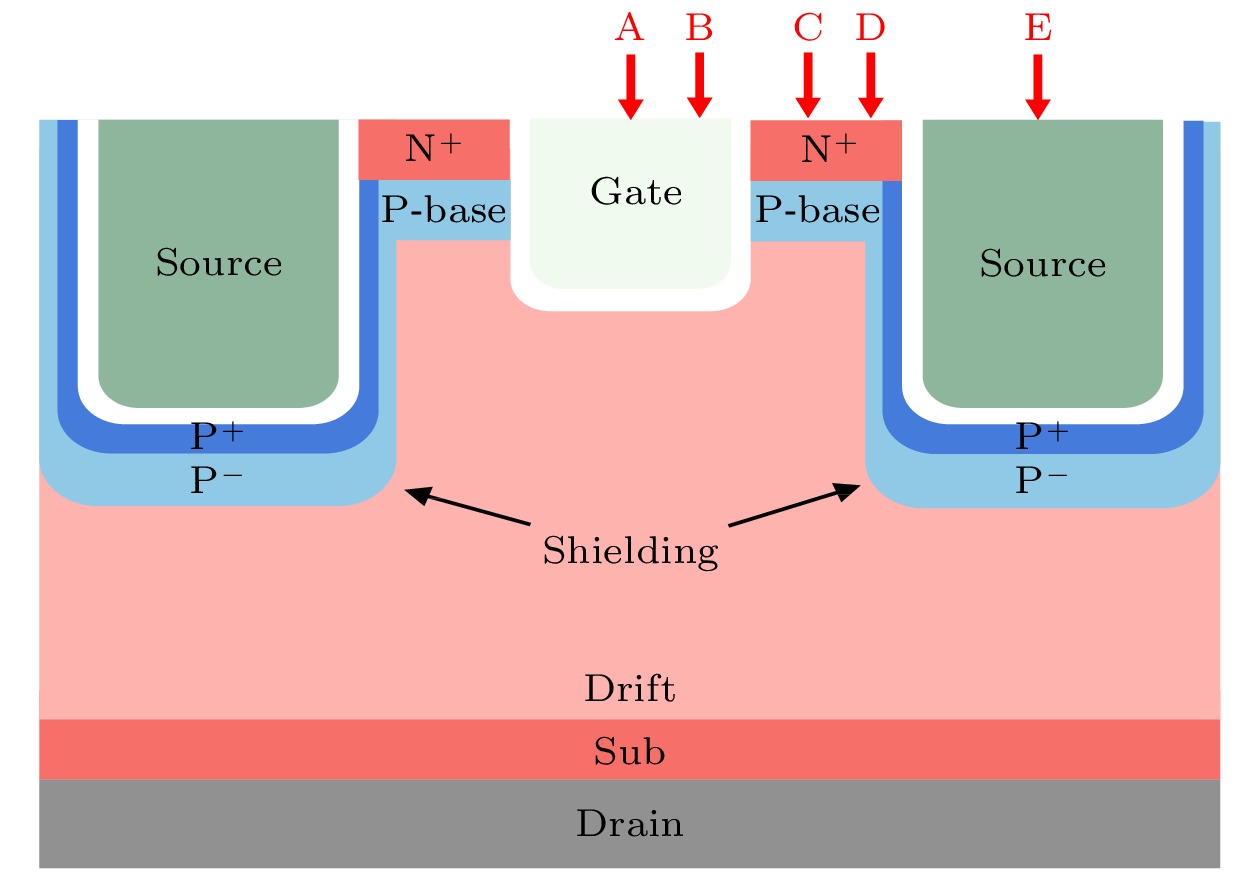
2024, 73 (2): 026103.
doi: 10.7498/aps.73.20231440
Abstract +
In this paper, experiments on 208 MeV Ge ion irradiation with different source-drain bias voltages are carried out for the double-trench SiC metal–oxide–semiconductor field-effect transistors, and the physical mechanism of the single event effect is analyzed. The experimental results show that the drain leakage current of the device increases more obviously with the increase of the initial bias voltage during irradiation. When the bias voltage is 400 V during irradiation, the device has a single event burned at a fluence of 9×104 ion/cm2, and when the bias voltage is 500 V, the device has a single event burned at a fluence of 3×104 ion/cm2, so when the LET value is 37.3 MeV·cm2/mg, the SEB threshold of DUT does not exceed 400 V, which is lower than 34% of the rated operational voltage. The post gate-characteristics test results show that the leakage current of the device with a bias voltage of 100 V does not change significantly during irradiation. When the bias voltage is 200 V, the gate leakage and the drain leakage of the device both increase, so do they when the bias voltage is 300 V, which is positively related to bias voltage. In order to further analyze the single particle effect mechanism of device, the simulation is conducted by using TCAD tool. The simulation results show that at low bias voltage, the heavy ion incident device generates electron-hole pairs, the electrons are quickly swept out, and the holes accumulate at the gate oxygen corner under the effect of the electric field, which combines the source-drain bias voltage, leading to the formation of leakage current channels in the gate oxygen layer. The simulation results also show that at high bias voltage, the electrons generated by the incident heavy ion move towards the junction of the N– drift layer and the N+ substrate under the effect of the electric field, which further increases the electric field strength and causes significant impact ionization. The local high current density generated by the impact ionization and the load large electric field causes the lattice temperature to exceed the melting point of silicon carbide, causing single event burnout. This work provides a reference and support for studying the radiation effect mechanism and putting silicon carbide power devices into aerospace applications.
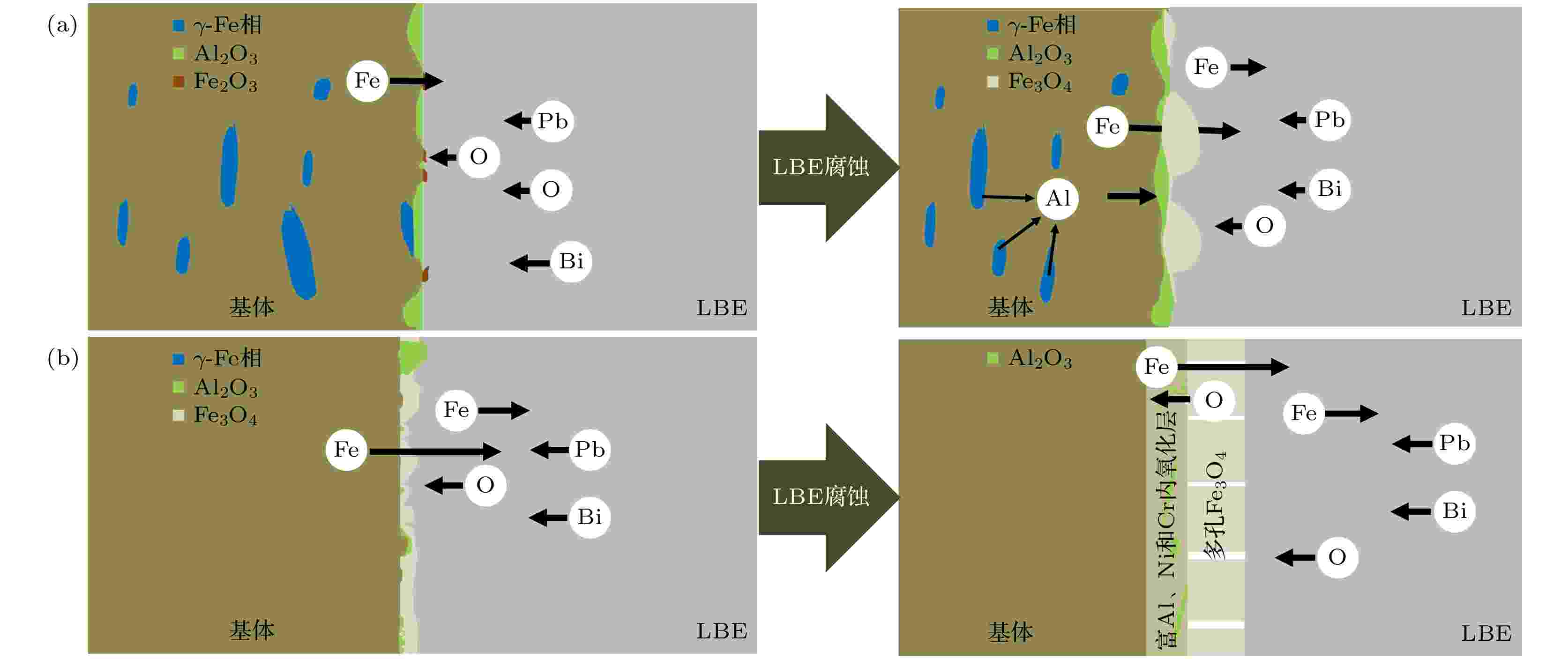
2024, 73 (2): 026104.
doi: 10.7498/aps.73.20231103
Abstract +
The key material issue for the commercialization of advanced lead cooled fast reactors and accelerator driven subcritical systems is the compatibility between structural materials and lead based coolants. Structural steel materials require excellent corrosion resistance in high-temperature liquid lead bismuth eutectic (LBE) alloy. Aluminum forming austenitic steel (AFA steel) has excellent corrosion resistance in extreme environments due to its ability to form an Al2O3 film on its surface. However, excessively high Ni elements are more easily dissolved or oxidized in LBE than Fe and Cr elements. Therefore, this work investigates the effect of reducing Ni element composition (25-Ni steel and 18-Ni steel) on the corrosion resistance of steel in LBE. Surface treatment can protect the substrate from corrosion to some extent, so herein we explore whether it has a protective effect on AFA steel in LBE by generating Al2O3 through high-temperature pre oxidation. The morphology and structure of the oxide layer of AFA steel corroded for 600 h in LBE with saturated dissolved oxygen at 550 ℃ are characterized by scanning electron microscope (SEM), energy dispersive spectrometer (EDS), X-ray diffraction (XRD), and other technologies. The results indicate that the oxide film formed after corrosion of 18-Ni steel is thinner than that after corrosion of 25-Ni steel. Performing high-temperature pre oxidation is beneficial to forming a protective Al2O3 oxide film on the surface of the sample, thereby reducing the thickness of the oxide layer and improving the material’s LBE corrosion resistance. The reduction in thickness of the oxide layer generated after pre oxidation of 18-Ni steel is greater than that of 25-Ni steel, so the anti-corrosion effect of 18-Ni steel after pre oxidation is better than that of 25-Ni steel.
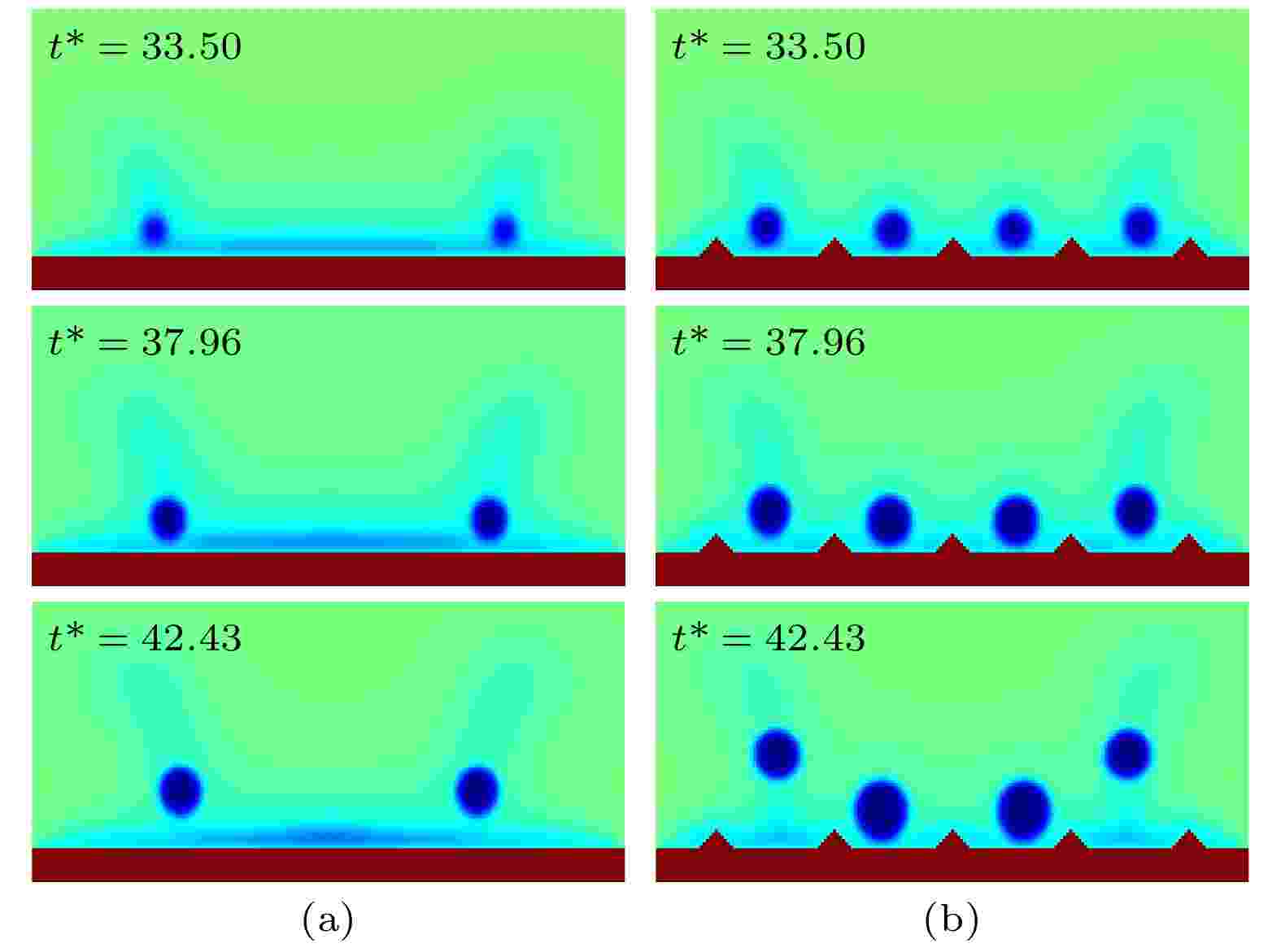
2024, 73 (2): 026401.
doi: 10.7498/aps.73.20231141
Abstract +
The saturated pool boiling heat transfer on a conical structure surface under the action of an electric field is numerically investigated by using the lattice Boltzmann (LB) model coupled with an electric field model. A comparison study of boiling heat transfer phenomenon smooth surface and conical surface without the action of an electric field is first conducted in order to quantitatively analyze the mechanism of the electric field effect on boiling heat transfer on the conical structure surface. It is discovered that the conical structure has more active nucleation sites during the nucleate boiling regime, improving the boiling heat transfer efficiency and enhancing the critical heat flux (CHF). However, in the transition boiling stage and film boiling stage, the conical structure increases the flow resistance of the fluid on the fin surface, hindering heat transfer between the vapor and liquid and producing lower heat transfer performance than smooth surface. Based on the aforementioned findings, the boiling heat transmission on the conical structure surface is enhanced by applying an electric field. Numerical results indicate that the effect of the electric field on the boiling heat transfer performance on the conical structure surface is related to the boiling regime. In the earlier stage of the nucleation boiling regime, when an electric field is present, the onset time of bubble nucleation is slightly delayed, bubble size decreases a little, and boiling is slightly suppressed. However, the combination effect of electric field and conical structure, especially the tip effect, prevents the spread and diffusion of dry areas on the heating surface, thereby enhancing boiling heat transfer in the fully developed nucleate boiling stage. The tip effect grows more evidently in the transition boiling regime and film boiling regime, and increasing electric field intensity causes boiling to continue in the nucleate boiling regime at a higher superheat level. As a result, boiling heat transfer performance is greatly improved, and CHF steadily rises.
COVER ARTICLE
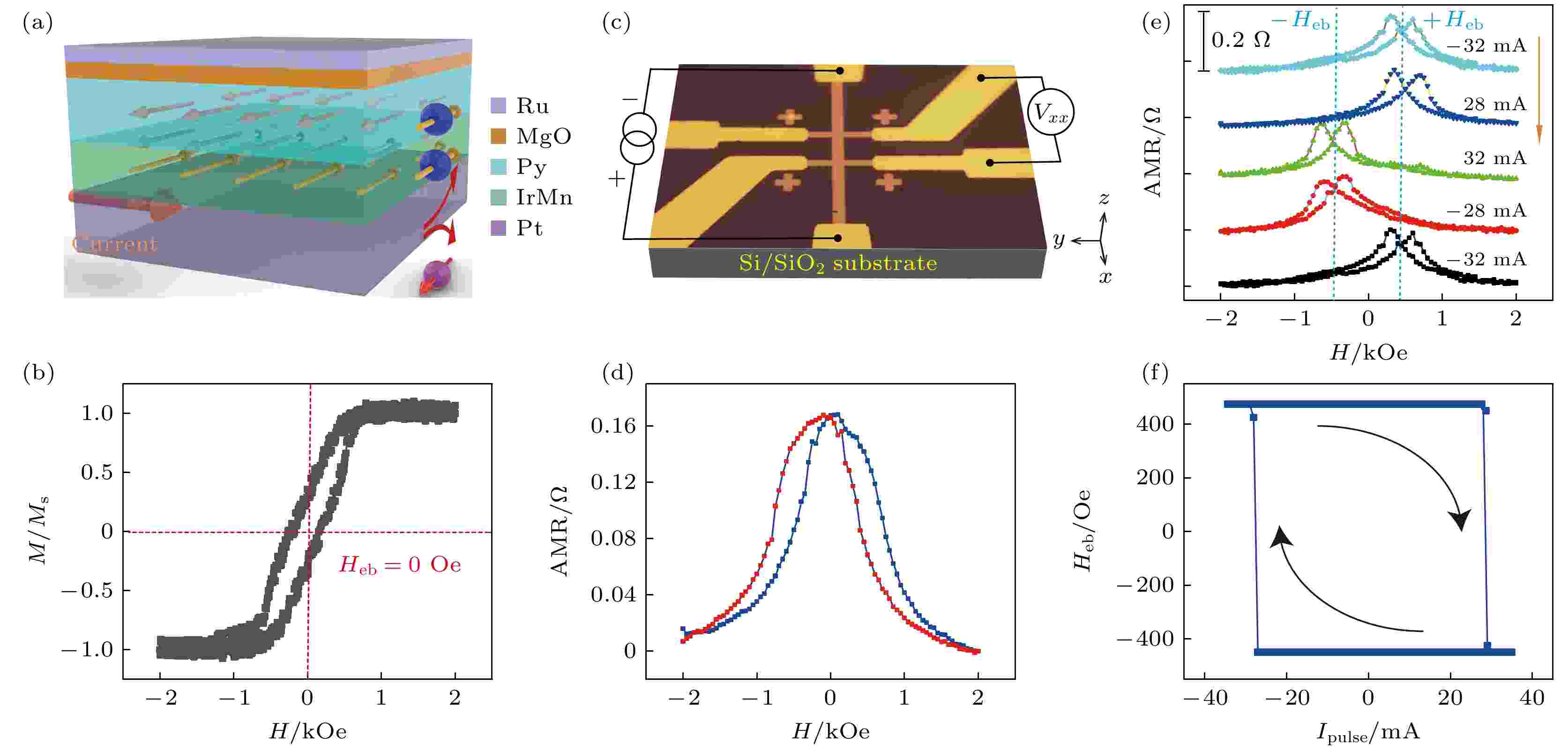
COVER ARTICLE
2024, 73 (2): 027501.
doi: 10.7498/aps.73.20231374
Abstract +
The current-induced switching of in-plane exchange bias field (Heb) has many advantages, such as switching without assistance of external magnetic field, excellent immunity to magnetic field, and robust magnetic anisotropy. However, the blocking temperature of the nanoscale antiferromagnet/ferromagnet (AFM/FM) heterostructure is relatively low and susceptible to thermal effects. Therefore, the Joule heating theoretically plays a substantial role in the switching of Heb driven by current, but its underlying mechanism requires further investigation and verification. We prepare a series of Pt/IrMn/Py heterostructures with varying antiferromagnet IrMn thicknesses and systematically investigate the role of thermal effects in current-driven Heb switching. These results demonstrate that under millisecond-level current pulses, Joule heating heats the device above the blocking temperature, leading to the decoupling of exchange coupling at AFM/FM interface. Simultaneously, the Oersted field and spin-orbit torque field generated by the current switch the ferromagnetic moments, and then a new Heb will be induced along the direction of the ferromagnetic moments in the cooling process. Furthermore,in the switching process of Heb, the anisotropic magnetoresistance curve of the AFM/FM heterostructure exhibits a temperature-dependent two-step magnetization reversal phenomenon. Theoretical analysis indicates that this phenomenon arises from the competitive relationship between exchange bias coupling at AFM/FM interface and direct exchange coupling between the ferromagnetic moments. The findings of this study elucidate the crucial role of thermal effects in the current-driven switching of Heb, thereby contributing to the advancement of spintronic devices based on electrically controlled Heb.
CONDENSED MATTER: ELECTRONIC STRUCTURE, ELECTRICAL, MAGNETIC, AND OPTICAL PROPERTIES
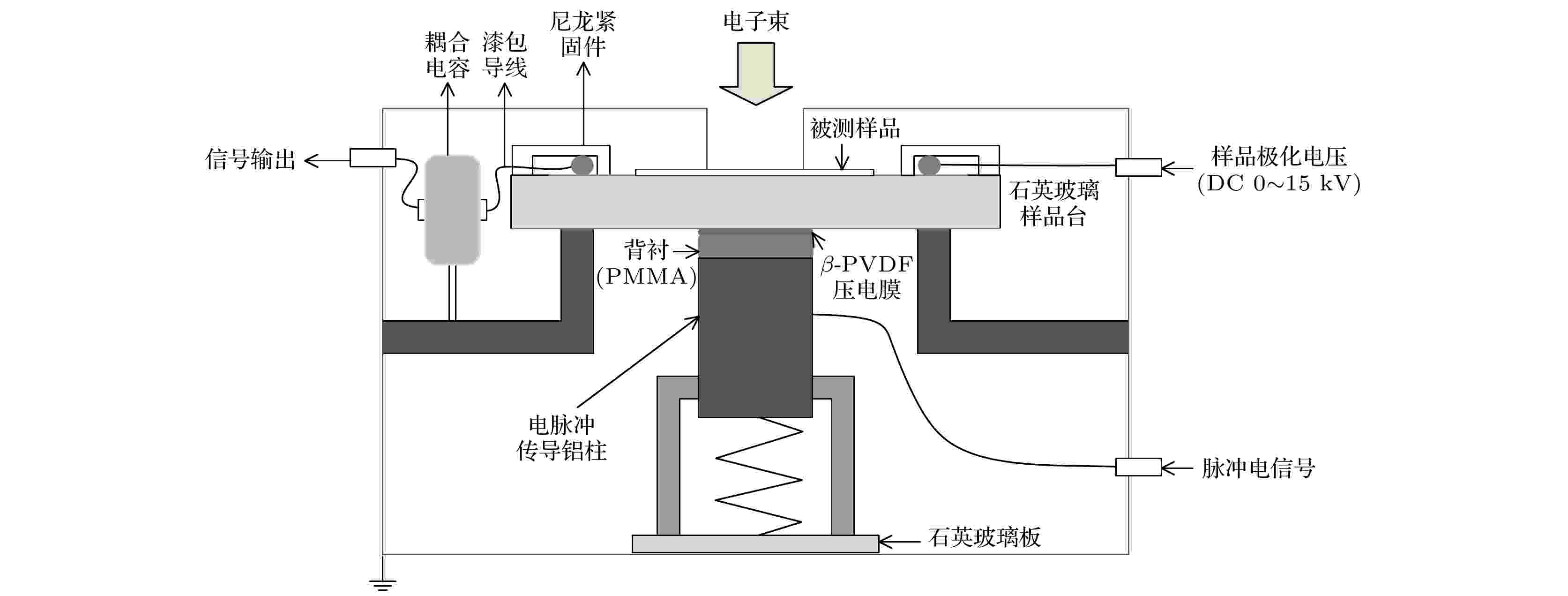
EDITOR'S SUGGESTION
2024, 73 (2): 027701.
doi: 10.7498/aps.73.20231353
Abstract +
The space charge packet is a special sort of space charge phenomenon that is characterized by the migration of aggregated space charge in the form of a packet in the sample. Currently, most of the experimental and simulation studies on the generation and migration of space charge packets focus on the space charge packets with positive polarity in polyethylene and their cross-linking products, while the characteristics of the space charge packets with negative polarity still need studying. This paper presents an integrated experimental system for studying space charge packet with negative polarity, which enables experimental studies combining electron beam irradiation technique and real-time space charge distribution measurement. The beam flux for electron beam irradiation is controlled by a metal grid with an optical fiber-electric relay, and the space charge distribution measurement is performed by the piezo- pressure wave propagation method. The system achieves a withstand voltage value of 17 kV and a measuring resolution of 25 ns for space charge distribution measurement and is suitable for experimental studies of various material samples with different thickness ranges under different electric fields. In this work, the migration behaviors of space charge packets with negative polarity in polypropylene (PP) and polymethyl methacrylate (PMMA) samples under different applied electric fields (15, 20, 25, 30 kV/mm) are studied by using the experimental system. The relationship between the migration properties of carriers with negative polarity (electrons) and the electric field can be extracted from the experimental results. The “negative differential mobility” phenomenon is found for both materials, i.e. the migration rate decreases with the increase of the electric field. The threshold electric field for the “negative differential mobility” phenomenon of electrons in PP sample is about 26.0 kV/mm while the threshold electric field for the “negative differential mobility” phenomenon of electrons in PMMA sample is 19.5 kV/mm, and the phenomenon disappears at an electric field of 27.5 kV/mm. The electric field where the "negative differential mobility" phenomenon of electrons appears and disappears in different materials can be extracted by using the experimental system proposed in this paper.
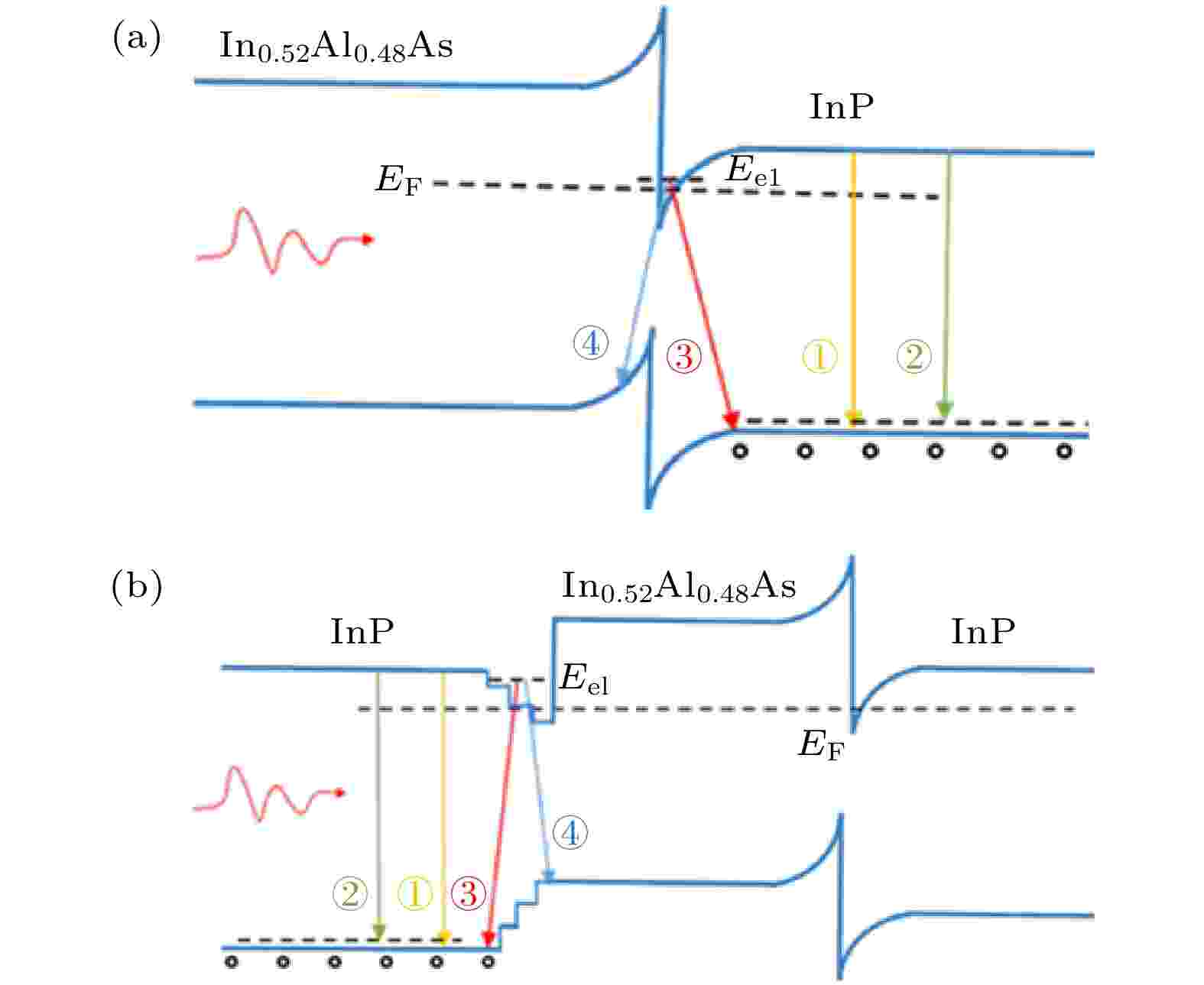
EDITOR'S SUGGESTION
2024, 73 (2): 027801.
doi: 10.7498/aps.73.20231339
Abstract +
Photoconductivity (PC) spectroscopy and photoluminescence (PL) spectroscopy were used to characterize two heterostructure configurations of InAlAs/InP grown by molecular beam epitaxy (MBE) on the InP (100) substrate. The sample A is the type called normal heterostructure, which has an In0.52Al0.48As layer grown on InP, while sample B is called the inverse type formed by an InP cap layer on In0.52Al0.48As. The front excitation was employed in both PC experiment and PL experiment and the measurements were conducted at 77 K. The PC spectrum of sample A shows an abnormal step-like drop when the photon energy is larger than the energy band gap of In0.52Al0.48As. The phenomenon implies that the conductance of sample is a multilayer effect including the contribution of interfacial two-dimensional electron gas (2DEG). Moreover, a conductance peak is observed at 916 nm below the bandgap of InP. Accordingly, an intense luminescent peak at the wavelength manifests in the PL spectrum. The origin of the 916 nm peak is attributed to the recombination of 2DEG electrons with the valence band holes excited near the interface. However, the spectral feature of the above energy does not exist in both PC and PL spectra of sample B. This difference may be explained by the different interface electronic structures of the inverse interface. For the latter case, considering that a graded variation in In-As-P composition is related to the inverse interface of InP/InAlAs, the band bending effect should be weak. In such a case, the bound energy of 2DEG in the interface potential well is raised closer to the conductance band of the bulk. Consequently, the recombination energy of 2DEG at the inverse interface with the holes in the valence band is close to the band-to-band transition of InP bulk and the luminescence is difficult to be distinguished from that of bulk InP. The work also demonstrates that the comparative study with both PC technique and PL technique is helpful to provide a full insight into the interface electronic property.
INTERDISCIPLINARY PHYSICS AND RELATED AREAS OF SCIENCE AND TECHNOLOGY

2024, 73 (2): 028101.
doi: 10.7498/aps.73.20231064
Abstract +
A basic and important way to prepare diamond is to make graphite experience the phase transformation under the high-pressure high-temperature (HPHT) condition. However, this method needs stringent equipment and high investment cost. Recently, we proposed a method to prepare the diamond by phase transformation of graphite at atmospheric pressure with monodispersed Ta atoms. It is found that a phase transformation happens to H atoms under atmospheric pressure, but the role of O atoms has not been investigated. Here, we use tantalum wires as Ta source and heat the filaments to prepare vertical graphene containing Ta atoms in hot filament chemical vapor deposition (HFCVD) system. And then the vertical graphene layers are annealed in oxygen-containing environment, and nanodiamonds are obtained by phase transformation from the vertical graphene under atmospheric pressure. The results show that the sample morphologies are the same as the untreated vertical graphene’s, when the annealed ambient air pressure is at 10 Pa and 50 Pa with oxygen atom content of 1.96% and 2.04%, respectively; TEM tests reveal TaC and graphite but no diamond in these samples . Nanodiamond grains with the size range of 2–4 nm are observed in the amorphous carbon region of samples annealed at 100 Pa and 500 Pa air pressure with oxygen atom content increasing to 2.77% and 3.11%, respectively, indicating that oxidation facilitates the phase change from Ta-containing vertical graphene to diamond at atmospheric pressure. When the air pressure of the annealing environment rises to 1000 Pa with the oxygen atom content of 3.54%, the sample is extensively oxidized and the graphite structure is severely damaged,which means that a large number of oxygen atoms tend to disrupt the graphite structure rather than promote the phase change into diamond. These results supply a way to prepare nanodiamond and show the effect of O atoms in the graphite phase transition at atmospheric pressure.

EDITOR'S SUGGESTION
2024, 73 (2): 028201.
doi: 10.7498/aps.73.20231361
Abstract +
Li-ion batteries (LIBs) are widely used in mobile devices and electric vehicles, but the traditional layered transition metal cathode material, LiTMO2 (TM=Ni, Co, Mn, or Al), has a low energy density that cannot satisfy the demand of commercial applications. The Li-rich Mn-based layered oxides (LRLOs) are a strong competitor to the traditional layered cathode materials for their specific capacity of more than 200 mAh/g. Due to the high energy density and low cost, Li-rich Mn-based layered oxides (LRLO) have been a promising candidate cathode for next-generation Li-ion batteries. The anionic redox reaction (ARR) in LRLO destabilizes the lattice oxygen, leading to voltage degradation and capacity loss. Although iron-substituted cobalt-free Li-rich materials can achieve less voltage decay, they suffer severe cation disorder and poor kinetics. Here, we develop a simple and feasible high-valent ion doping strategy by doping Mo into Li1.2Ni0.13Fe0.13Mn0.54O2(LNFMO), which expands the Li layer spacing and provides a broader channel for Li+ transport, thereby improving the diffusion kinetics of Li+, effectively suppressing the cation disorder, and further stabilizing the layered structure. As a result, the Mo-doped LRLO exhibits significantly enhanced electrochemical performance, with an initial reversible capacity of 209.48 mAh/g at 0.2 C, and the initial specific capacity increasing from 137.02 mAh/g to 165.15 mAh/g at 1 C. After 300 cycles, specific capacity remains 117.49 mAh/g for the Mo-doped cathode, and the voltage decay decreases from 2.09 mV/cycle to 1.66 mV/cycle. The Mo-doped LRLO is systematically characterized, and the mechanism of cycle stabilization is revealed, which provides an important reference for designing high performance Li-rich cathode.

2024, 73 (2): 028801.
doi: 10.7498/aps.73.20231061
Abstract +
Perovskite solar cells have been a prominent focus in the field of photovoltaics in recent decades, owing to their exceptional performance: easy synthesis, and cost-effectiveness. The all-inorganic cesium-based perovskite CsPbBr3, known for its remarkable thermal stability, has become a star material in the field of optoelectronics due to its outstanding luminescent properties. Despite the high efficiency of lead-based perovskite solar cells, the toxicity associated with lead and the poor long-term stability of these devices remain significant barriers to their large-scale commercialization. As is well known, non-radiative electron-hole recombination significantly shortens the carrier lifetime, acting as a primary pathway for excited state charge to loss energy. This phenomenon directly affects the photovoltaic conversion efficiency and charge transfer performance of perovskite materials. Therefore, maximizing the reduction of non-radiative recombination energy loss in perovskite solar cells has become a crucial research focus. In this study, a systematic exploration is conducted by using a non-adiabatic molecular dynamics approach combined with time-dependent density functional theory to investigate the excited-state carrier dynamics of CsPbBr3 and its alloyed structures, CsPb0.75Ge0.25Br3 and CsPb0.5Ge0.25Sn0.25Br3. The study comprehensively analyzes the non-radiative electron-hole recombination scenarios and the mechanisms for reducing charge energy loss based on crystal structure, electronic properties, and excited-state properties. The research findings reveal that alloying with Sn/Ge can reduce the bandgap, increase non-adiabatic coupling, and shorten the decoherence time. The interplay of reduced quantum decoherence, smaller bandgap, and larger non-adiabatic coupling effectively decelerates the electron-hole recombination process. Consequently, the carrier lifetime of the CsPb0.75Ge0.25Br3 system extends by 1.6 times. Moreover, under the joint influence of Sn/Ge, the carrier lifetime of the CsPb0.5Ge0.25Sn0.25Br3 system extends by 4.2 times compared with those of the original system. The overall sequence follows CsPb0.5Ge0.25Sn0.25Br3 > CsPb0.75Ge0.25Br3 > CsPbBr3. This study underscores the significant influence of binary alloying of B-site metal cations (in the perovskite structure ABX3, where B-site refers to the metal cation) on the non-radiative electron-hole recombination of CsPbBr3.This research presents an effective alloying scheme that substantially prolongs the carrier lifetime of perovskites, offering a rational approach to optimizing solar cell performance. It lays the groundwork for the future design of perovskite solar cell materials.
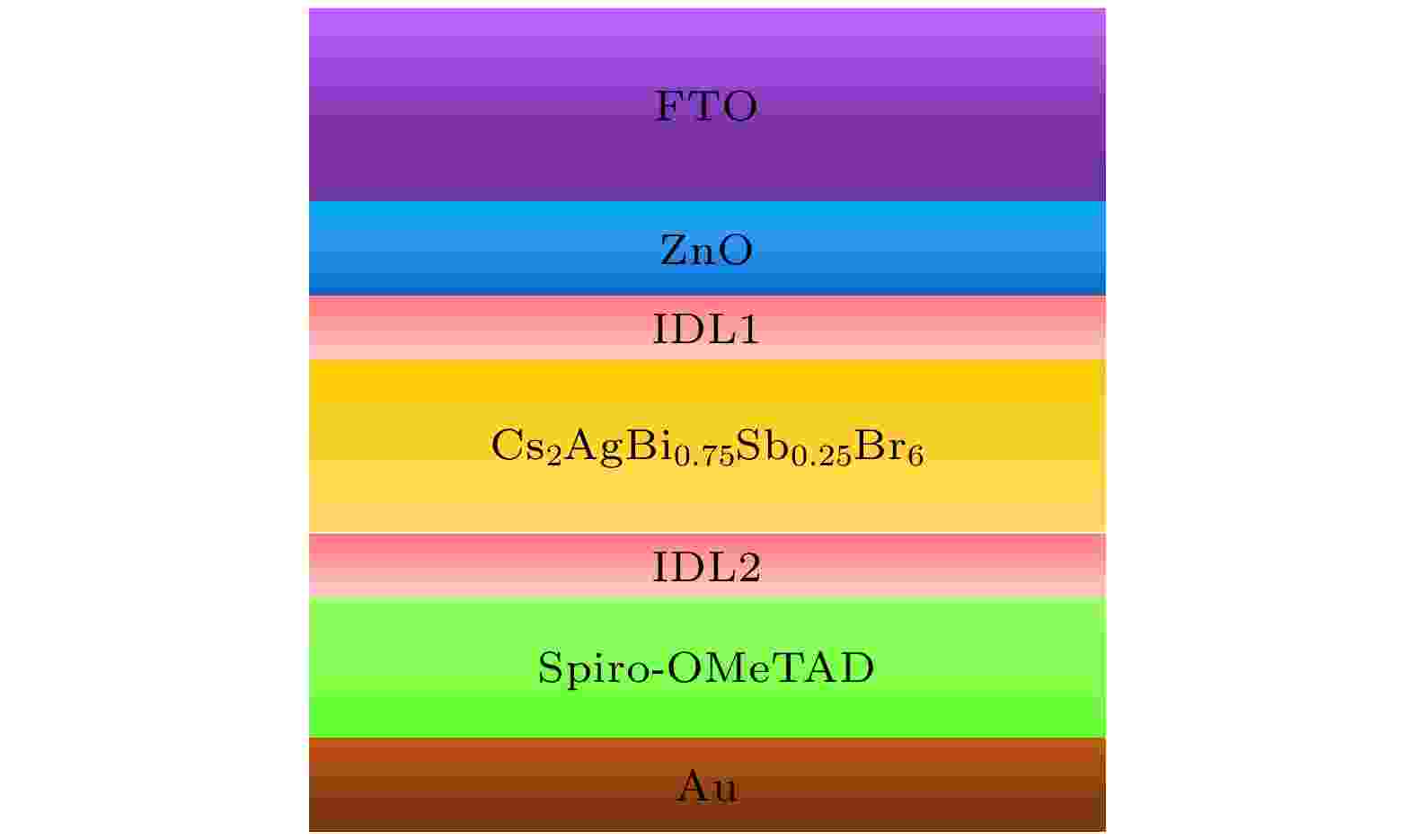
2024, 73 (2): 028802.
doi: 10.7498/aps.73.20231299
Abstract +
Double perovskite solar cells have attracted much attention due to their low cost, high performance, environmental friendliness, and strong stability. In this study, the effect of thickness of perovskite layer, band offset, metal electrode work function, the thickness and doping concentration of the transport layer on the efficiency of Cs2AgBi0.75Sb0.25Br6 solar cells are analyzed by using Silvaco TCAD to improve device performance. This preliminary study of device based on Spiro-OMeTAD as hole transport layer (HTL) and ZnO as electron transport layer (ETL) shows that the photovoltaic conversion efficiency (PCE) is 12.66%. The results show that the efficiency gradually saturates when the thickness of the perovskite layer is greater than 500 nm. The optimal conduction band offset (CBO) ranges from 0 eV to +0.5 eV and the optimal valence band offset (VBO) from –0.1 eV to +0.2 eV. After changing the device's ETL into ZnOS and HTLs into MoO3, Cu2O and CuSCN, respectively, and optimizing their thickness values and doping concentrations, the final theoretical photovoltaic conversion efficiency of the double perovskite solar cell with an HTL of Cu2O can reach 22.85%, which is increased by 25.6% compared with the currently reported theoretical efficiency value. Moreover, the optimal efficiency is achieved when the metal electrode work function is less than –4.9 eV. This work will help find suitable materials for the transport layer and provide guidance for developing the high-performance and lead-free perovskite solar cells.








